Cultural Identity Essay
27 August, 2020
12 minutes read
Author: Elizabeth Brown
No matter where you study, composing essays of any type and complexity is a critical component in any studying program. Most likely, you have already been assigned the task to write a cultural identity essay, which is an essay that has to do a lot with your personality and cultural background. In essence, writing a cultural identity essay is fundamental for providing the reader with an understanding of who you are and which outlook you have. This may include the topics of religion, traditions, ethnicity, race, and so on. So, what shall you do to compose a winning cultural identity essay?


Cultural Identity Paper: Definitions, Goals & Topics

Before starting off with a cultural identity essay, it is fundamental to uncover what is particular about this type of paper. First and foremost, it will be rather logical to begin with giving a general and straightforward definition of a cultural identity essay. In essence, cultural identity essay implies outlining the role of the culture in defining your outlook, shaping your personality, points of view regarding a multitude of matters, and forming your qualities and beliefs. Given a simpler definition, a cultural identity essay requires you to write about how culture has influenced your personality and yourself in general. So in this kind of essay you as a narrator need to give an understanding of who you are, which strengths you have, and what your solid life position is.
Yet, the goal of a cultural identity essay is not strictly limited to describing who you are and merely outlining your biography. Instead, this type of essay pursues specific objectives, achieving which is a perfect indicator of how high-quality your essay is. Initially, the primary goal implies outlining your cultural focus and why it makes you peculiar. For instance, if you are a french adolescent living in Canada, you may describe what is so special about it: traditions of the community, beliefs, opinions, approaches. Basically, you may talk about the principles of the society as well as its beliefs that made you become the person you are today.
So far, cultural identity is a rather broad topic, so you will likely have a multitude of fascinating ideas for your paper. For instance, some of the most attention-grabbing topics for a personal cultural identity essay are:
- Memorable traditions of your community
- A cultural event that has influenced your personality
- Influential people in your community
- Locations and places that tell a lot about your culture and identity
Cultural Identity Essay Structure
As you might have already guessed, composing an essay on cultural identity might turn out to be fascinating but somewhat challenging. Even though the spectrum of topics is rather broad, the question of how to create the most appropriate and appealing structure remains open.
Like any other kind of an academic essay, a cultural identity essay must compose of three parts: introduction, body, and concluding remarks. Let’s take a more detailed look at each of the components:
Introduction
Starting to write an essay is most likely one of the most time-consuming and mind-challenging procedures. Therefore, you can postpone writing your introduction and approach it right after you finish body paragraphs. Nevertheless, you should think of a suitable topic as well as come up with an explicit thesis. At the beginning of the introduction section, give some hints regarding the matter you are going to discuss. You have to mention your thesis statement after you have briefly guided the reader through the topic. You can also think of indicating some vital information about yourself, which is, of course, relevant to the topic you selected.
Your main body should reveal your ideas and arguments. Most likely, it will consist of 3-5 paragraphs that are more or less equal in size. What you have to keep in mind to compose a sound ‘my cultural identity essay’ is the argumentation. In particular, always remember to reveal an argument and back it up with evidence in each body paragraph. And, of course, try to stick to the topic and make sure that you answer the overall question that you stated in your topic. Besides, always keep your thesis statement in mind: make sure that none of its components is left without your attention and argumentation.
Conclusion
Finally, after you are all finished with body paragraphs and introduction, briefly summarize all the points in your final remarks section. Paraphrase what you have already revealed in the main body, and make sure you logically lead the reader to the overall argument. Indicate your cultural identity once again and draw a bottom line regarding how your culture has influenced your personality.
Best Tips For Writing Cultural Identity Essay
Writing a ‘cultural identity essay about myself’ might be somewhat challenging at first. However, you will no longer struggle if you take a couple of plain tips into consideration. Following the tips below will give you some sound and reasonable cultural identity essay ideas as well as make the writing process much more pleasant:
- Start off by creating an outline. The reason why most students struggle with creating a cultural identity essay lies behind a weak structure. The best way to organize your ideas and let them flow logically is to come up with a helpful outline. Having a reference to build on is incredibly useful, and it allows your essay to look polished.
- Remember to write about yourself. The task of a cultural identity essay implies not focusing on your culture per se, but to talk about how it shaped your personality. So, switch your focus to describing who you are and what your attitudes and positions are.
- Think of the most fundamental cultural aspects. Needless to say, you first need to come up with a couple of ideas to be based upon in your paper. So, brainstorm all the possible ideas and try to decide which of them deserve the most attention. In essence, try to determine which of the aspects affected your personality the most.
- Edit and proofread before submitting your paper. Of course, the content and the coherence of your essay’s structure play a crucial role. But the grammatical correctness matters a lot too. Even if you are a native speaker, you may still make accidental errors in the text. To avoid the situation when unintentional mistakes spoil the impression from your essay, always double check your cultural identity essay.
A life lesson in Romeo and Juliet taught by death
Due to human nature, we draw conclusions only when life gives us a lesson since the experience of others is not so effective and powerful. Therefore, when analyzing and sorting out common problems we face, we may trace a parallel with well-known book characters or real historical figures. Moreover, we often compare our situations with […]

Ethical Research Paper Topics
Writing a research paper on ethics is not an easy task, especially if you do not possess excellent writing skills and do not like to contemplate controversial questions. But an ethics course is obligatory in all higher education institutions, and students have to look for a way out and be creative. When you find an […]

Art Research Paper Topics
Students obtaining degrees in fine art and art & design programs most commonly need to write a paper on art topics. However, this subject is becoming more popular in educational institutions for expanding students’ horizons. Thus, both groups of receivers of education: those who are into arts and those who only get acquainted with art […]
How to Write a Cultural Identity Essay With Tips and Examples
11 December 2023
last updated
Writing a cultural identity essay is an exciting academic exercise that allows students to develop and utilize critical thinking, reflective, and analytical skills. Unlike a standard essay, this type of paper requires learners to use first-person language throughout. In essence, a cultural identity essay is about writers and what makes them identify with a particular cultural orientation. When writing a cultural identity essay, authors should choose a specific identity and focus on it throughout their texts. Moreover, they should reflect and brainstorm, use the “show, not tell” method, utilize transitions to create a natural flow, and proofread their papers to eliminate mistakes and errors. Hence, students need to learn how to write a cultural identity essay to provide high-quality papers to their readers.
Definition of a Cultural Identity Essay
Students undertake different writing exercises in the learning environment to develop their critical thinking, reflective, and analytical skills. Basically, one of these exercises is academic writing , and among different types of essays that students write is a cultural identity essay. In this case, it is a type of essay where authors write about their culture, which entails exploring and explaining the significance of their cultural identity. Moreover, there are numerous topics that instructors may require students to write about in a cultural identity essay. For example, some of these essay topics fall under different disciplines, such as religion, socio-economic status, family, education, ethnicity, and business. In essence, the defining features of a cultural identity essay are what aspects make authors know that they are writing in this type of essay. In turn, these features include language, nationality, gender, history, upbringing, and religion, among many others.
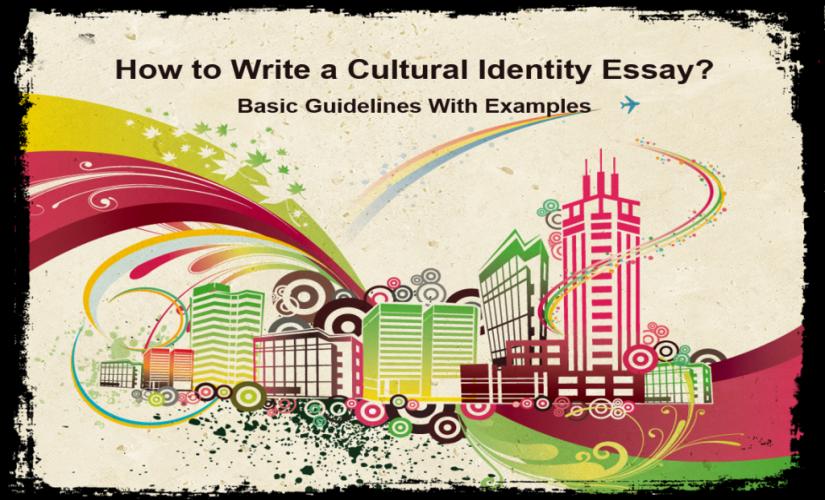
Differences Between a Cultural Identity Essay and Other Papers
Generally, a cultural identity essay is similar to a standard essay regarding an essay structure and an essay outline . However, the point of difference is the topic. While standard essays, such as argumentative, persuasive, and informative essays, require learners to use third-person language, such a paper requires them to use first-person language. In this case, when writing a cultural identity essay, authors should use the word “I” throughout to show the audience that they are writing from their perspective. Indeed, this aspect is the primary objective of a cultural identity essay – to give the writer’s perspective concerning their culture. Besides, another point of difference between a cultural identity essay and other papers is that the former does not require writers to utilize external sources but to write from a personal viewpoint.
List of Possible Examples of Cultural Identity Essay Topics
1. cultural identity and socialization in a learning environment.
Here, a cultural identity essay prompt may require students to discuss the significance of culture in education, focusing on cultural identity and socialization. As such, this topic requires writers to reflect on how culture influences behavior in a learning environment.
2. The Impact of Culture Change on Family
Here, this prompt may require students to explore and discuss how culture impacts a family unit. Moreover, the theme is a family, and the students’ mission would be to explain how culture in all its dynamics affects families in diverse settings.
3. The Role of Language in Building a Cultural Identity
Here, instructions may require students to explore and explain the significance of language in cultural identity. Hence, writers should focus on explaining the place of culture in the sociology discipline, focusing on the connection between language and cultural identity.
4. The Significance of Culture in a Globalized Economy
Here, a cultural identity essay topic may require students to explore and discuss how culture affects individuals and businesses in today’s connected world. Also, the students’ task would be to explain how culture, in all its dynamics, such as language, is essential in business for individuals and enterprises.
5. How Culture Influences Relations in the Workplace
Here, an essay prompt may require students to explore and explain how culture, in all its dynamics, affects or influences social relations at the workplace. In turn, the task of writers, for example, would be to focus on how Human Resource (HR) departments can use culture to enrich workplace relations.
6. The Place of Culture in Individuals’ Self-Concept
Here, an analysis of a theme may require students to reflect on how their cultural orientation has affected their self-concept. Moreover, the student’s task would be to discuss how culture and its dynamics enable individuals to build a strong or weak understanding of themselves.
7. The Importance of Cultural Orientation in a Multicultural Environment
Here, assignment instructions may require students to explore and discuss how their cultural orientation enables them to operate in a culturally diverse environment, such as a school or workplace. In this case, the student’s task would be to explain how cultural characteristics, such as language and religion, facilitate or hamper social competency in a multicultural setting.
8. How Global Conflicts Disturb Cultural Identity for Refugees
Here, this example of a cultural identity topic may require students to explore and explain how conflicts in today’s world, such as civil unrest, affect the cultural identity of those who flee to foreign countries. Also, the student’s task would be to explain how one’s culture is affected in a new environment with totally different cultural dynamics.
9. The Challenges of Acculturation
Here, a cultural identity essay prompt may require students to explore and explain the challenges that individuals face in identifying with the dominant culture. In particular, the student’s task would be to explain the significance of the dominant culture and what those from other cultures that try to identify with it must confront.
10. Host Country Culture and Multinational Enterprises
Here, this prompt sample may require students to explore and explain how a host country’s culture affects expatriates working for multinational corporations. Besides, the students’ task would be to show how one’s culture defines their behaviors and how that can be affected in a new environment with new cultural characteristics.
11. Compare and Contrast Native Culture and Dominant Culture in the United States
Here, such instructions require students to explain specific areas of similarity and difference between the Native culture and the dominant culture. In turn, the students’ task would be to define the Native culture and the dominant culture and help the audience to understand whether they mean the same thing. Hence, whether they do or do not, students should elaborate.
12. The Objective of Acculturation
Here, this example of a cultural identity essay topic requires students to explore and explain why people prefer to identify with the dominant culture. Moreover, the students’ task would be to note the advantages of the dominant culture over others and the opportunities that one may access to identify with this dominant culture.
13. The Challenges That the LGBTQ Community Faces in the Modern World
Here, essay prompt instructions require students to explore and discuss the challenges that lesbians, gays, bisexuals, and transgender people face in their normal day-to-day activities. In this case, the students’ task would be to explain the uniqueness of the LGBTQ community and how stereotyping makes their lives miserable in an environment where people are intolerant of different personalities and viewpoints.
14. Dangers of Cultural Intolerance in the Health Care System
Here, instructions may require students to explore and discuss how nurses that are intolerant to cultural differences may jeopardize patients’ lives.
15. Advantages and Disadvantages of Acculturation
Here, a cultural identity essay prompt requires students to discuss the pros and cons of identifying with the dominant culture.
How Students Know if They Write a Cultural Identity Essay
The defining features of a cultural identity essay give students the indication that they need to write this kind of essay. Basically, when learners read instructions regarding their essay topics they need to write about, they should identify one or several defining elements. In turn, these elements include language, nationality, religion, ethnicity, and gender.
Structure of a Cultural Identity Essay
As stated previously, the primary point of similarity between a cultural identity essay and standard papers is an essay structure and an essay outline. Basically, this structure and outline comprise of three main sections: introduction, body, and conclusion. Like in all other essays, writing a cultural identity essay requires students to address specific issues, which are, in essence, the defining characteristics of the essay’s structure and outline.
I. Introduction and Its Defining Characteristics
The introduction is the first paragraph of a cultural identity essay. Here, students introduce themselves to the audience, giving a brief background of their cultural identity. Moreover, rules of academic writing dictate that this part should not exceed 10 percent of the entire paper. In this case, writers should be brief and concise. Then, the most prominent component of this section is a thesis, a statement that appears at the end of an introduction paragraph and whose objective is to indicate the writer’s mission. In summary, the introduction part’s defining features are the writer’s background and thesis statement . In turn, the former gives a hint about a writer, and the latter provides the audience with insight into the writer’s objective in writing a cultural identity essay.
The body of a cultural identity essay is the most significant section of a paper and takes the largest part. Generally, writers use several paragraphs to advance different arguments to explain specific concepts. In a cultural identity essay, writers can use different paragraphs to explain important aspects of their cultural identity. Nonetheless, what determines the number of paragraphs and the content of each is a paper topic. Also, the most prominent defining features of a cultural identity essay’s body are paragraphs, with each advancing a unique concept about the writer’s cultural identity. In turn, paragraphs are where writers provide real-life experiences and other personal anecdotes that help the audience to develop a deeper understanding of authors from a cultural perspective.
III. Conclusion
The conclusion part is the last section of a cultural identity essay. In particular, writers restate a thesis statement and summarize the main points from body paragraphs. Moreover, authors provide concluding remarks about a topic, which is mostly an objective personal opinion. In summary, the conclusion part’s defining features are a restatement of a thesis, a summary of the main points, and the writer’s final thoughts about a topic.
Outline Template for a Cultural Identity Essay
I. Introduction
A. Hook statement/sentence. B. Background information. C. A thesis statement that covers the main ideas from 1 to X in one sentence.
II. Body Paragraphs
A. Idea 1 B. Idea 2 … X. Idea X
A. Restating a thesis statement. B. Summary of the main points from A to X. C. Final thoughts.
An Example of a Cultural Identity Essay
Topic: Identifying as a Naturalist
I. Introduction Sample in a Cultural Identity Essay
The period of birth marks the beginning of one’s identity, with culture playing a significant role. However, from the stage of adolescence going forward, individuals begin to recognize and understand their cultural makeup. In my case, I have come to discover my love for nature, an aspect that I believe has made me a naturalist both in belief and action.
II. Examples of Body Paragraphs in a Cultural Identity Essay
A. idea 1: parents.
Parents play a critical role in shaping the cultural and personal identity of their children. In my case, it is my mother who has instilled in me a love for nature. Although I may not say exactly when this love started, I can only reason that since it was ingrained in me since childhood, it has developed gradually.
B. Idea 2: Naturalism
Today, naturalism defines my interactions with people and the environment. In short, I can say it shapes my worldview. As a lover of nature herself, my mother had this habit of taking me outdoors when I was a toddler. I have seen family photographs of my mother walking through parks and forests holding my hand. What is noticeable in these pictures besides my mother and me is the tree cover that gives the setting such a lovely sight. Moreover, I can now understand why I seem more conversant with the names and species of flowers, trees, and birds than my siblings- my mother was the influence. In turn, my siblings and friends make a joke that I have developed a strong love for nature to the point of identifying myself with the environment. Hence, the basis for this argument is my love for the green color, where even my clothes and toys are mostly green.
III. Conclusion Sample of a Cultural Identity Essay
Naturally, human beings behave in line with their cultural background and orientation. Basically, this behavior is what determines or reflects their cultural identity. In turn, my intense love for nature underscores my naturalist identity. While I may not tell the stage in life when I assumed this identity, I know my mother has played a significant role in shaping it, and this is since childhood.
Summing Up on How to Write a Good Cultural Identity Essay
Like any standard paper, writing a cultural identity essay allows students to build essential skills, such as critical thinking, reflective, and analytical skills. In this case, the essence of a paper is to provide the writer’s cultural identity, background, or orientation. Therefore, in order to learn how to write a good cultural identity essay, students should master the following tips:
- Decide where to focus. Culture is a broad topic, and deciding what to focus on is essential in producing a cultural identity essay. For example, one may have several cultural identities, and addressing all may lead to inconclusive explanations.
- Reflect and brainstorm. Given the close link between one’s cultural identity and personal experiences, learners need to reflect on experiences that would provide the audience with an accurate picture of their cultural identity.
- Adopt the “Show, not tell” approach by providing vivid details about one’s experiences. Using personal anecdotes may be effective in accomplishing this objective.
- Use transitions , such as “therefore,” “thus,” ” additionally,” and “furthermore,” to enhance a natural and logical flow throughout the essay.
- Stay personal by using first-person language to describe one’s background and experiences.
- Proofread a cultural identity essay to eliminate spelling and grammatical mistakes and other notable errors, such as an inconsistent life storyline.
To Learn More, Read Relevant Articles
How to cite a dsm-5 in apa 7 and 6: guidelines with examples, how to cite an encyclopedia in mla 9: the main rules with examples.
- Subject List
- Take a Tour
- For Authors
- Subscriber Services
- Publications
- African American Studies
- African Studies
- American Literature
- Anthropology
- Architecture Planning and Preservation
- Art History
- Atlantic History
- Biblical Studies
- British and Irish Literature
- Childhood Studies
- Chinese Studies
- Cinema and Media Studies
Communication
- Criminology
- Environmental Science
- Evolutionary Biology
- International Law
- International Relations
- Islamic Studies
- Jewish Studies
- Latin American Studies
- Latino Studies
- Linguistics
- Literary and Critical Theory
- Medieval Studies
- Military History
- Political Science
- Public Health
- Renaissance and Reformation
- Social Work
- Urban Studies
- Victorian Literature
- Browse All Subjects
How to Subscribe
- Free Trials
In This Article Expand or collapse the "in this article" section Cultural Identity
Introduction, early influential works.
- Core Texts and Articles
- Textbooks and Readers
- Communication Journals
- Interdisciplinary Journals
- Ethnicity and Race in Communication
- Cross-Cultural and Intercultural Communication
- Cultural Identity and Health Communication
- Sexuality and Culture
Related Articles Expand or collapse the "related articles" section about
About related articles close popup.
Lorem Ipsum Sit Dolor Amet
Vestibulum ante ipsum primis in faucibus orci luctus et ultrices posuere cubilia Curae; Aliquam ligula odio, euismod ut aliquam et, vestibulum nec risus. Nulla viverra, arcu et iaculis consequat, justo diam ornare tellus, semper ultrices tellus nunc eu tellus.
- Acculturation Processes and Communication
- Attitude-Behavior Consistency
- Co-Cultural Theory and Communication
- Cognitive Dissonance
- Critical and Cultural Studies
- Cultural Pluralism and Communication
- Ethnic Media
- Ethnography of Communication
- Feminist Theory
- Health Communication
- Intercultural Communication
- Intercultural Friendships
- Intergroup Communication
- Interpersonal LGBTQ Communication
- Multicultural Families
- Queer Intercultural Communication
- Social Construction
- Social Movements
- Stereotypes
- Third Culture Kids
- Tourism and Intercultural Communication
Other Subject Areas
Forthcoming articles expand or collapse the "forthcoming articles" section.
- Culture Shock and Communication
- LGBTQ+ Family Communication
- Queerbaiting
- Find more forthcoming titles...
- Export Citations
- Share This Facebook LinkedIn Twitter
Cultural Identity by Yea-Wen Chen , Marion G. Mendy LAST REVIEWED: 12 January 2021 LAST MODIFIED: 12 January 2021 DOI: 10.1093/obo/9780199756841-0254
Cultural identity is a multidimensional concept that has fascinated scholars, researchers, and practitioners in (intercultural) communication and related disciplines over time. The year 2020 has witnessed renewed interests in and debates about a multiplicity of cultural identities, which demonstrate the concept’s relevance in everyday interactions across local and global contexts. For instance, both the rise of conservatism across the globe (including white nationalism in the United States during the Trump administration) and the push for greater equity and inclusion for all (e.g., Black Lives Matter movement, sexual misconduct policies, and gender-neutral bathrooms in public spaces) have garnered and regenerated needs to better understand cultural identity as a complex and contested communication construct. Analytically, cultural identity encompasses a wide range of socially constructed categories that influence how a person knows and experiences his/her/their social world (e.g., race, ethnicity, gender, nationality, socioeconomic status, ability, sexuality, religion, and more). As a social construct, cultural identity deals with important questions about conceptions, understandings, and lived experiences regarding the self in relation to others across time, space, and context. In particular, cultural identity—as opposed to identity—focuses on questions regarding membership in, acceptance into, (dis)identification with, and/or negotiation of (un)belongingness to various groups vis-à-vis communication. Questions about “difference” in a myriad of ways are at the heart of inquiries about cultural identity. That is, cultural identity is better understood as “cultural identities” as always already plural, intersecting, and evolving along various power lines that relate to histories, politics, and social forces. Communication scholars have studied the concept of cultural identity from different perspectives and approaches (e.g., functionalist, interpretive, and critical lenses). In this article, influential works are identified and reviewed in related fields such as psychology, sociology, and cultural studies that have shaped the study of cultural identity in (intercultural) communication in US academia. Then, core texts and articles in communication are considered that represent key issues, core debates, and central arguments about cultural identities, which are followed by textbooks and readers, a review of journals, and prominent theories of cultural identity by intercultural communication scholars in the United States. The article ends with major areas of study.
The scholarship of cultural identity is influenced by intellectual thoughts across disciplines such as anthropology, psychology, sociology, philosophy, linguistics, and cultural studies. The foundation of cultural identity is about how the self experiences, locates, communicates, and/or performs himself/herself/themselves in relation to ingroup and outgroup members within existing social hierarchies. Several key publications pave the way for understanding cultural identity as quintessentially a communication phenomenon with cultural particularities, situated-ness, and significance within and across groups. Across the different perspectives on and approaches to cultural identity, much of the current understanding is influenced by and builds on the work of the following studies in a chronological order. Du Bois 1994 (first published in 1903) examines conflicting identities experienced by Black Americans at the dawn of the 20th century. Published posthumously, Mead 1934 describes symbolic interactionism based on student notes of Mead’s lectures on social psychology at the University of Chicago together with selections from unpublished manuscripts that Mead left. Goffman 1959 offers dramaturgy as a framework to understand the presentation of self as everyday performance. Rooted in the identity experiences of the colonized Others, Said 1978 describes a conceptualization of orientalism. Tajfel 1981 develops social identity theory to understand the experiences of ingroup and outgroup members. Foucault 1982 offers a view of identity in response to power relations and knowledge. Anzaldúa 1987 offers border/lands theory to describe the experiences of living and straddling between two or multiple worlds. Hall and du Gay 1996 is a collection of essays featuring postmodern approaches to identity. In particular, Hall and du Gay 1996 stresses that the issue of cultural identity has been vigorously debated in social theories.
Anzaldúa, G. 1987. Borderlands/La Frontera: The new mestiza . San Francisco, CA: Aunt Lute Books.
In this influential work, Anzaldúa coins and develops borderlands theory to capture the rich struggles of living within and outside cultures, languages, and social structures that are both safe and unsafe such as Chicanas growing up in South Texas long the US-Mexico border. Anzaldúa’s work both challenges marginalizing and oppressing systems and embraces new consciousness and lines of inquiries that draw from living/straddling between two worlds.
Du Bois, W. E. B. 1994. The souls of black folk . New York: Dover.
In this groundbreaking book, Du Bois coins an influential term “double-consciousness” to describe the experience and awareness of living with conflicting and irreconcilable identities (e.g., as both “Negro” and “American”). His book details the lived struggles of the doubly conscious Black Americans straddled in two conflicting worlds in the early 20th century, which has legitimized the realities of many racial and minoritized Others and also has served as the foundation for a great deal of cultural identity theorizing and studies. Originally published 1903.
Foucault, M. 1982. The subject and power. Critical Inquiry 8.2: 777–795.
DOI: 10.1086/448181
In this essay, Foucault offers a view of identity in which power formations and circulations make individuals “subjects.” As subjects, individuals are both subject to power and control by others and tied to his identity by a conscience resulting from power and self-knowledge. Foucault further details what constitutes power, how power is exercised, and how power relation can be analyzed in the creation of subjectivity as discursive formations.
Goffman, E. 1959. The presentation of self in everyday life . Garden City, NY: Anchor Books.
In dramaturgy, Goffman views individuals as social agents who present and perform their self-concepts in everyday communication interactions. Goffman considers that social agents present and perform their identity within any particular setting as consisting of a front stage and a back stage. Thus, Goffman highlights sociological understandings of the psychological processes through which individuals negotiate and perform who they are, and/or who they want to be, in social interactions according to not just personal experiences but also social norms.
Hall, S., and P. du Gay, eds. 1996. Questions of cultural identity . Los Angeles, CA: SAGE.
Reflecting a postmodern orientation to identity as anti-essentialist, malleable, and disjointed, the ten essays in Hall and du Gay’s edited collection feature a range of perspectives examining individual and collective identity formation, fragmentation, and deconstruction in discursive structures. As Hall argues in the introduction, “identities are constructed within, not outside, discourse” (p. 4). In this view, cultural identities are best understood in Hall’s words as “points of temporary attachment to the subject positions which discursive practices construct for us (1996, p. 6).
Mead, G. H. 1934. Mind, self, and society . Edited by C. W. Morris. Chicago: The Univ. of Chicago Press.
This original book outlines Mead’s system of social psychology, which is later termed “symbolic interactionism” by his student, Herbert Blumber. Mead offers concepts such as the “I,” the “me,” and “the generalized other” in developing a symbolic interactionist approach to identity. In this view, identity as a social process is developed through ongoing interactions in which the self interacts with the social world to (re)make meanings that inform self-consciousness.
Said, E. 1978. Orientalism . New York: Pantheon.
Orientalism systematically examines how Western scholarship (mis)represents the Orient (particularly the Near East and the Arab world) to subjugate the Orient in order to articulate and create the (superior) Occident. This book has been credited as the foundation for postcolonial scholarship as it legitimizes and offers the intellectual basis for counter-hegemonic criticism and pursuits of alternatives to Western-centric cannons, ideas, and voices.
Tajfel, H. 1981. Human groups and social categories . Cambridge, UK: Cambridge Univ. Press.
This key book serves as the foundation for Tajfel and colleagues’ development of social identity theory —an influential social psychological theory that inform a great deal of cultural identity studies in (intercultural) communication. Tajfel understands social identity as “the problems of an individual’s self-definition in a social context” (p. 254). Throughout this book, Tajfel considers and explains how an individual experiences and conceives his/her/their self-concept in intergroup relations with attention to issues of perceptual judgments, stereotypes, ethnocentrism, intergroup conflicts, and social psychology of minorities.
back to top
Users without a subscription are not able to see the full content on this page. Please subscribe or login .
Oxford Bibliographies Online is available by subscription and perpetual access to institutions. For more information or to contact an Oxford Sales Representative click here .
- About Communication »
- Meet the Editorial Board »
- Accounting Communication
- Action Assembly Theory
- Action-Implicative Discourse Analysis
- Activist Media
- Adherence and Communication
- Adolescence and the Media
- Advertisements, Televised Political
- Advertising
- Advertising, Children and
- Advertising, International
- Advocacy Journalism
- Agenda Setting
- Annenberg, Walter H.
- Apologies and Accounts
- Applied Communication Research Methods
- Argumentation
- Artificial Intelligence (AI) Advertising
- Audience Fragmentation
- Audience Studies
- Authoritarian Societies, Journalism in
- Bakhtin, Mikhail
- Bandwagon Effect
- Baudrillard, Jean
- Blockchain and Communication
- Bourdieu, Pierre
- Brand Equity
- British and Irish Magazine, History of the
- Broadcasting, Public Service
- Capture, Media
- Castells, Manuel
- Celebrity and Public Persona
- Civil Rights Movement and the Media, The
- Codes and Cultural Discourse Analysis
- Collective Memory, Communication and
- Comedic News
- Communication Apprehension
- Communication Campaigns
- Communication, Definitions and Concepts of
- Communication History
- Communication Law
- Communication Management
- Communication Networks
- Communication, Philosophy of
- Community Attachment
- Community Journalism
- Community Structure Approach
- Computational Journalism
- Computer-Mediated Communication
- Content Analysis
- Corporate Social Responsibility and Communication
- Crisis Communication
- Critical Race Theory and Communication
- Cross-tools and Cross-media Effects
- Cultivation
- Cultural and Creative Industries
- Cultural Imperialism Theories
- Cultural Mapping
- Cultural Persuadables
- Cyberpolitics
- Death, Dying, and Communication
- Debates, Televised
- Deliberation
- Developmental Communication
- Diffusion of Innovations
- Digital Divide
- Digital Gender Diversity
- Digital Intimacies
- Digital Literacy
- Diplomacy, Public
- Distributed Work, Comunication and
- Documentary and Communication
- E-democracy/E-participation
- E-Government
- Elaboration Likelihood Model
- Electronic Word-of-Mouth (eWOM)
- Embedded Coverage
- Entertainment
- Entertainment-Education
- Environmental Communication
- Experiments
- Families, Multicultural
- Family Communication
- Federal Communications Commission
- Feminist and Queer Game Studies
- Feminist Data Studies
- Feminist Journalism
- Focus Groups
- Food Studies and Communication
- Freedom of the Press
- Friendships, Intercultural
- Gatekeeping
- Gender and the Media
- Global Englishes
- Global Media, History of
- Global Media Organizations
- Glocalization
- Goffman, Erving
- Habermas, Jürgen
- Habituation and Communication
- Hermeneutic Communication Studies
- Homelessness and Communication
- Hook-Up and Dating Apps
- Hostile Media Effect
- Identification with Media Characters
- Identity, Cultural
- Image Repair Theory
- Implicit Measurement
- Impression Management
- Infographics
- Information and Communication Technology for Development
- Information Management
- Information Overload
- Information Processing
- Infotainment
- Innis, Harold
- Instructional Communication
- Integrated Marketing Communications
- Interactivity
- Intercultural Capital
- Intercultural Communication, Tourism and
- Intercultural Communication, Worldview in
- Intercultural Competence
- Intercultural Conflict Mediation
- Intercultural Dialogue
- Intercultural New Media
- Intergenerational Communication
- International Communications
- Interpersonal Communication
- Interpretation/Reception
- Interpretive Communities
- Journalism, Accuracy in
- Journalism, Alternative
- Journalism and Trauma
- Journalism, Citizen
- Journalism, Citizen, History of
- Journalism Ethics
- Journalism, Interpretive
- Journalism, Peace
- Journalism, Tabloid
- Journalists, Violence against
- Knowledge Gap
- Lazarsfeld, Paul
- Leadership and Communication
- Mass Communication
- McLuhan, Marshall
- Media Activism
- Media Aesthetics
- Media and Time
- Media Convergence
- Media Credibility
- Media Dependency
- Media Ecology
- Media Economics
- Media Economics, Theories of
- Media, Educational
- Media Effects
- Media Ethics
- Media Events
- Media Exposure Measurement
- Media, Gays and Lesbians in the
- Media Literacy
- Media Logic
- Media Management
- Media Policy and Governance
- Media Regulation
- Media, Social
- Media Sociology
- Media Systems Theory
- Merton, Robert K.
- Message Characteristics and Persuasion
- Mobile Communication Studies
- Multimodal Discourse Analysis, Approaches to
- Multinational Organizations, Communication and Culture in
- Murdoch, Rupert
- Narrative Engagement
- Narrative Persuasion
- Net Neutrality
- News Framing
- News Media Coverage of Women
- NGOs, Communication and
- Online Campaigning
- Open Access
- Organizational Change and Organizational Change Communicat...
- Organizational Communication
- Organizational Communication, Aging and
- Parasocial Theory in Communication
- Participation, Civic/Political
- Participatory Action Research
- Patient-Provider Communication
- Peacebuilding and Communication
- Perceived Realism
- Personalized Communication
- Persuasion and Social Influence
- Persuasion, Resisting
- Photojournalism
- Political Advertising
- Political Communication, Normative Analysis of
- Political Economy
- Political Knowledge
- Political Marketing
- Political Scandals
- Political Socialization
- Polls, Opinion
- Product Placement
- Public Interest Communication
- Public Opinion
- Public Relations
- Public Sphere
- Queer Migration and Digital Media
- Race and Communication
- Racism and Communication
- Radio Studies
- Reality Television
- Reasoned Action Frameworks
- Religion and the Media
- Reporting, Investigative
- Rhetoric and Communication
- Rhetoric and Intercultural Communication
- Rhetoric and Social Movements
- Rhetoric, Religious
- Rhetoric, Visual
- Risk Communication
- Rumor and Communication
- Schramm, Wilbur
- Science Communication
- Scripps, E. W.
- Selective Exposure
- Sense-Making/Sensemaking
- Sesame Street
- Sex in the Media
- Small-Group Communication
- Social Capital
- Social Change
- Social Cognition
- Social Identity Theory and Communication
- Social Interaction
- Social Network Analysis
- Social Protest
- Sports Communication
- Strategic Communication
- Superdiversity
- Surveillance and Communication
- Symbolic Interactionism in Communication
- Synchrony in Intercultural Communication
- Tabloidization
- Telecommunications History/Policy
- Television, Cable
- Textual Analysis and Communication
- Third-Person Effect
- Time Warner
- Transgender Media Studies
- Transmedia Storytelling
- Two-Step Flow
- United Nations and Communication
- Urban Communication
- Uses and Gratifications
- Video Deficit
- Video Games and Communication
- Violence in the Media
- Virtual Reality and Communication
- Visual Communication
- Web Archiving
- Whistleblowing
- Whiteness Theory in Intercultural Communication
- Youth and Media
- Zines and Communication
- Privacy Policy
- Cookie Policy
- Legal Notice
- Accessibility
Powered by:
- [66.249.64.20|81.177.182.136]
- 81.177.182.136
Custom Essay, Term Paper & Research paper writing services
- testimonials
Toll Free: +1 (888) 354-4744
Email: [email protected]
Writing custom essays & research papers since 2008
Electrifying guide to a cultural identity essay.

“The beauty of the world lies in the diversity of its people.” A simple statement but carrying worth centuries and decades of wisdom. In layman’s language, the account would mean that without diversity, then the world would be one boring place to stay.
Imagine the world with only men, or women, or even animals from one place alone. It wouldn’t have been impressive as it is now with people from all walks of life. And robots are also joining the community, adding to the diversity of this blooming planet, earth.
So, what is culture? Simply put, it denotes the ways of life of different people. It can be in various aspects, such as the following:
- Social relations
These are just but a few of how different people differ from each other. Now, to what brought you here, what is a cultural identity essay?
Definition of a Cultural Identity Essay
A cultural identity paper is one that brings out the identity of a person concerning the place where they grew up, religion, economic, or family status. Cultural identity, therefore, means a group of people that one can identify within his/her essay. But wait, there’s more!
Structure of a Cultural Identity Essay
Essays about cultural identity take the same format as other types of academic essay assignments. So, what’s the catch?
The main difference between a cultural identity essay and the other types is that it, unlike the others, it uses the first-person pronoun (I and We).
To add on that, hardly will students be required to do citations of sources because this paper is more of personal experiences. Students will, therefore, need to have substantial background information to come up with an outstanding cultural identity paper.
The MLA formatting style takes center stage in this type of essay. One would need to be creative enough and have sufficient information to convince the reader. Here are some sources you could use for your cultural identity essay:
- Your parents (preferably the grandparents)
- Television documentaries on culture
- History books in libraries
Bear in mind that all these sources should be operating or found in your national or locality. Let me tell you why.
People who are from a particular area understand their culture and heritage than those from outside. Can a visitor to come to your house for the first time and know what is under your bed? I bet no.
The crucial differences which distinguish human societies and human beings are not biological. They are cultural. Ruth Benedict.
Are you ready for some cultural identity essay ideas? Then, move that scroll wheel downwards.
Cultural Identity Essay Ideas for You!
The ideas are so many ideas that you can choose from for your essay on cultural identity. A starting point would be asking yourself, “What is my cultural identity?”. You can consider the following ideas:
- An experience that you went through
- The story behind a specific famous locality
- The impact of a particular culture
- A common practice among people and where it originated from
- Think of one particular language and trace its roots
- How have the people around you influenced you?
- What kinds of food do you eat differently from others, and why?
- How do you feel when sited with a person of a different race?
- How do you dress, and why?
- The impact your religion has had on you
- What activities did you engage in as a child?
Again the ideas are not limited to what I have listed above. Have you ever watched a football derby, let’s say between Barcelona and Real Madrid? Do you see the number of spectators in attendance? Well, the ideas for essays about identity are more than that.
You may also make use of the numerous cultural identity essay examples found on the internet to generate more ideas. We advise you to take a look at racism essay topics .
And as if that’s not enough, let me share some tips that will help a long way in cranking up your next cultural identity essay.
Great Tips for an Excellent Essay on Cultural Identity
Let’s get down to them right away.
- Significant on personal experiences unless stated otherwise
- Make use of linking words
- Use vivid description
- MLA formatting
- Don’t assume, every detail matters
Although these are general tips, their application in your essay will make a high impact on your grades. Now, this is important.
How Would you Describe your Cultural Identity?
A vivid description of the use of personal experiences is the most recommended way that you can use.
What Are Examples of Cultural Identity?
They include nationality, ethnicity, religion, social class, generation, and locality, just but a few to mention.
Why is Having a Cultural Identity Important?
It gives people a sense of belonging to a particular social or ethnic group. Cultural identity also contributes to acknowledging and balancing the beliefs and values of other people and their cultures.
Difference Between Culture and Identity?
Culture is a way of life of a particular group of people, whereas identity is the knowledge of who you are as a person.
It is as simple and straightforward as that. A cultural identity essay would not take you more than an hour to complete with the tips and outline given above. Take one of the recommended ideas above and start writing an essay on it. You will be amazed at how far you’ve improved your skills in cultural identity essays.
We know that writing an essay for your college assignment would prove tough for you, especially without an excellent writing service . Dubious websites would lure you into giving them your work and later disappoint you with low quality work at high rates. However, with us, we offer professional writers with years of expertise and a proven track record from our thousands of clients.

What is a cultural identity essay, and how to write one?

Writing an essay is one of the most common assignments that students encounter in colleges and universities. Also, students need to write an essay during their admissions as the academic institution is much interested in knowing more about the student and the background that they come from. One of the essential types of essays in this sphere is a cultural identity essay. But what exactly is cultural identity?
Cultural identity refers to the factors like race, religious background, customs, traditions, etc., followed by a person. It is not only based on belonging to a certain background, but the cultural identity also influences the similarities that students might have with other group members, including habits, customs, beliefs, faith, etc. Now that we are clear with what cultural identity is let us look at how to essay it.
Subscribe to our YouTube channel for more related videos
The structure and goal of a cultural identity essay Like any other personal essay, a cultural identity essay will help you express your personality and demonstrate what kind of a person you are. It should reflect what makes you unique and should effectively demonstrate your strengths and academic potential. A cultural identity essay will also help to encompass your cultural influences and the driving philosophies and beliefs.
It helps the reader understand what makes you focused and unique. For example, when writing on being an Indian, the faith and traditions you grew up with and how they were responsible for shaping your personality should be discussed. Additionally, write about your religious beliefs and everything it entails discussing the prevalent traditions, rituals, and beliefs in your community.
The structure of a cultural identity essay The structure of such an essay follows the basic structure just like any other essay. The length depends on the information you wish to share. Typically, it should be around 5 paragraphs long; however, the length requirement is dependent on the school or university. It is an overview of the major elements of the essay.
- Introduction: The section should be used to introduce you to the reader. Tell the audience about your cultural background and how it has influenced you into becoming the person you are today. The introduction length is determined by the total length of the essay and should not be more than 10 per cent of the total word count. Ensure not to tell everything in this section and wait until the later sections to reveal more information.
- Thesis: It is technically the last sentence of the introduction section. However, due to its importance, it should be separated from the other sections. It will prove an argumentative point that you wish to prove and will reflect the purpose of the work. For example, is your focus based on being an African American? Use the thesis to mention it and how it has affected you.
- Body: The main section of the essay that you would want to use to disclose all the major information about your cultural background. Break it down into proper subsections for better organisation. The body paragraph should not extend more than 5 pages or 1500 words for a cultural identity essay. If your essay is a short one, the body section should have a minimum of one section. Provide logical connections between the different sections of the body paragraphs. Show how different beliefs and cultures have shaped your personality and their influence on you while growing up. Enhance better readability by introducing appropriate opening and closing sentences.
- Conclusion: Use this section to revise the major points mentioned in the essay and emphasise the thesis to express how it has shaped you while growing up.
Tips for writing an effective cultural identity essay: Here are some tips to keep in mind while writing your cultural identity essay and can be extremely helpful in writing an effective essay.
- Choosing focus: Before starting the essay, you need to understand your cultural identity and select a topic based on it. Ensure to pick a topic that resonates well with you. The more passionate you are about the topic, the more compelling your essay will be.
- Brainstorming ideas: Contrary to popular belief, figuring out what has influenced your personality requires a lot of thought. It is an important step that you cannot afford to miss. It will help you list out all the essential aspects of your cultural identity, helping you to outline them when writing the essay properly.
- Create an outline: Before you start writing, ensure to develop a rough outline to figure out the logical placement of information. It is very useful since it helps you remember every key point that needs to be added to the different sections of the cultural identity essay. Stick to the outline when writing the essay to have a cohesive essay.
- Describe: Use personal experiences to describe their effects on your personality. It will help the readers to correlate your experiences with your background strongly. When starting a unique ethnic identity, simply stating it is not enough; you will need to provide as many details as you can recall.
- Use transition words: Transition words help to maintain the logical flow of your essay. Use the proper opening and closing sentences in each paragraph to enhance readability. Use transition words to bridge the gap between your ideas to give them a logical and semantic flow. Do not randomly present facts and instead use a logical sequence. Use different paragraphs to focus on different ideas to make the essay flow smoothly.
- Stay personal: With cultural identity essays, the main focus is on you and therefore, you need to be as personal as possible to give the best insight into who you are. Do not shy away from expressing personal experiences with the reader to develop a deeper connection.
- Proofread: Just like any other essay, proofreading is a crucial step that you cannot avoid. Take your time to revise the essay and spot any mistakes with spelling or grammar. Ensure to remove all errors before you submit the essay.
Cultural identity essays: Common points of focus There are several aspects of your cultural background that you can choose to focus on in your essay. For example, you can write about your gender and how it influenced your experiences while growing up. Religion can also be chosen as a point of focus. You can also choose to focus on language and customs that have shaped your growing years, and focusing on language can be a great idea if you speak more than one language. Choose any powerful experience to share in your cultural identity essay.
Frequently Asked Questions
What is a cultural identity essay.
A cultural identity essay is a personal statement essay that explores the student’s cultural backgrounds and their effect on their personality.
When do you need to write a cultural identity essay?
Cultural identity essays are an important part of college or university admission processes that help the board understand the candidate’s personality.
What is the basic structure of a cultural identity essay?
Just like other academic essays, a cultural identity essay can be divided into four distinct parts. These include the introduction, thesis, body and conclusion.
How long should the cultural identity essay introduction section be?
The introduction section of a cultural identity essay should be limited to around 10 per cent of the total word count.
Total Assignment Help Incase, you are looking for an opportunity to work from home and earn big money. TotalAssignmenthelp Affiliate program is the best choice for you.
Do visit : https://www.totalassignmenthelp.com/affiliate-program for more details
Total Assignment help is an assignment help Online service available in 9 countries. Our local operations span across Australia, US, UK, South east Asia and the Middle East. With extensive experience in academic writing, Total assignment help has a strong track record delivering quality writing at a nominal price that meet the unique needs of students in our local markets.
We have specialized network of highly trained writers, who can provide best possible assignment help solution for all your needs. Next time you are looking for assignment help, make sure to give us a try.
Looking for Assignment Help from Top Experts ?
Get the best Assignment Help from leading experts from the field of academics with assured onetime, 100% plagiarism free and top Quality delivery.
Thomas Smith
Related posts.
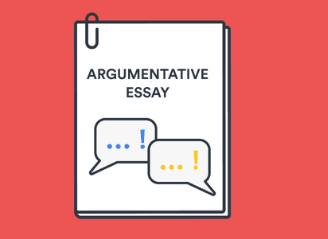
Refer To Argumentative Essay Examples To Write An Impeccable Argumentative Essay

Write Essays By Using Essay Planning Tips And Techniques

Learn How To Cite An Interview In Chicago Style With Examples
Leave a reply cancel reply.
Your email address will not be published. Required fields are marked *
Save my name, email, and website in this browser for the next time I comment.

- school Campus Bookshelves
- menu_book Bookshelves
- perm_media Learning Objects
- login Login
- how_to_reg Request Instructor Account
- hub Instructor Commons
- Download Page (PDF)
- Download Full Book (PDF)
- Periodic Table
- Physics Constants
- Scientific Calculator
- Reference & Cite
- Tools expand_more
- Readability
selected template will load here
This action is not available.


5.3: Writing about Race, Ethnic, and Cultural Identity: A Process Approach
- Last updated
- Save as PDF
- Page ID 14822

To review, race, ethnic, and cultural identity theory provides us with a particular lens to use when we read and interpret works of literature. Such reading and interpreting, however, never happens after just a first reading; in fact, all critics reread works multiple times before venturing an interpretation. You can see, then, the connection between reading and writing: as Chapter 1 indicates, writers create multiple drafts before settling for a finished product. The writing process, in turn, is dependent on the multiple rereadings you have performed to gather evidence for your essay. It’s important that you integrate the reading and writing process together. As a model, use the following ten-step plan as you write using race, ethnic, and cultural identity theory:
- Carefully read the work you will analyze.
- Formulate a general question after your initial reading that identifies a problem—a tension—related to a historical or cultural issue.
- Reread the work , paying particular attention to the question you posed. Take notes, which should be focused on your central question. Write an exploratory journal entry or blog post that allows you to play with ideas.
- What does the work mean?
- How does the work demonstrate the theme you’ve identified using a new historical approach?
- “So what” is significant about the work? That is, why is it important for you to write about this work? What will readers learn from reading your interpretation? How does the theory you apply illuminate the work’s meaning?
- Reread the text to gather textual evidence for support.
- Construct an informal outline that demonstrates how you will support your interpretation.
- Write a first draft.
- Receive feedback from peers and your instructor via peer review and conferencing with your instructor (if possible).
- Revise the paper , which will include revising your original thesis statement and restructuring your paper to best support the thesis. Note: You probably will revise many times, so it is important to receive feedback at every draft stage if possible.
- Edit and proofread for correctness, clarity, and style.
We recommend that you follow this process for every paper that you write from this textbook. Of course, these steps can be modified to fit your writing process, but the plan does ensure that you will engage in a thorough reading of the text as you work through the writing process, which demands that you allow plenty of time for reading, reflecting, writing, reviewing, and revising.
Peer Reviewing
A central stage in the writing process is the feedback stage, in which you receive revision suggestions from classmates and your instructor. By receiving feedback on your paper, you will be able to make more intelligent revision decisions. Furthermore, by reading and responding to your peers’ papers, you become a more astute reader, which will help when you revise your own papers. In Chapter 10, you will find peer-review sheets for each chapter.

Excellent essay writing blog for students seeking help with paper writing. We provide exclusive tips and ideas that can help create the best essay possible.
Writing An Excellent Cultural Identity Essay For All Levels

Before starting an identity essay, it’s important that you first consider what the assignment prompt is asking you to do. This kind of writing is closely associated with narrative writing because it can be quite personal, but sometimes you will need to write about others. In the latter case, you should refer to some cultural identity essay examples to learn how to talk about a cultural group you may not feel a part of without causing any offense. An identity essay can be tricky if you don’t fully understand the definition, so we will discuss it a bit in this article as well as give you a few ideas on the subject worth your consideration.
What is Cultural Identity?
The widely accepted definition of cultural identity is that it is the concept or belief of belonging to a specific group of people. This is, of course, filled with many sub-factors and is debatable because of the various cultural, historical, and generational characteristics (among others) that one can use to classify oneself or a group. It can be a bit complicated and many experts suggest that is no absolute definition since the characteristics one chooses to use often expand to overlap with others.
Students may find themselves having to write an essay response for an application or a personal narrative that asks them to answer the question “What is my cultural identity?” and not have a clear idea of where to begin. In such cases, it’s probably best for students to review an identity essay example to develop a better understanding of the best method for defining and writing a logical response. With a little bit of practice, students will get a full grasp of what readers are looking for when dealing with this subject. As for the structure and format, you can follow a typical five-paragraph essay outline.
12 Essay Topics on Identity Issues
The following 12 topics deal with a variety of areas appropriate for an identity paper assignment for high school, college, and graduate school courses. We encourage students to consider each one carefully and thoroughly, and then to apply their own twist to the ideas presented in order to make the subject truly personal:
- Language is an essential piece of what makes us who we are culturally speaking. But many people take their families traditional forms of communicating for granted and instead adopt a new language to fit in with their surroundings. Write a cultural identity essay about myself where you discuss being bi-lingual.
- Describe a real-life experience that helped you connect with a group in a self-identity essay. This can be a connection you felt with family, friends, or strangers. It should be something that you believe has influenced you to become the person you are today.
- How did the foods that you ate and the language that you spoke at home when growing up, affect the way you identify? Write a culture and identity essay focused on your family and upbringing. Consider how things were different from you than others in your neighborhood.
- Do you identify as an American or do you hold on to another country’s culture? Write an American identity essay where you explore what it means to be an American and whether or not the blinds between being single or multi-cultural is still relevant today.
- How does the way we communicate with family, friends, and strangers influence the way we think about identity? How are these two things linked and how important is the former to the latter? Write a language and identity essay exploring this relationship, and consider using personal examples.
- Write an ethnic identity essay comparing and contrasting two different groups of people that are often combined in generalized discussions. For instance, Chinese and Japanese, Mexican and Salvadorians, or English and Scottish, etc. How are these generalizations offensive and why are they still prevalent in media and the way people perceive them?
- With so many people conducting various day-to-day activities, are we to blame for being victims to cyber-crimes? Give an example of such a crime in an identity theft essay that examines cause and effect – and take an unbiased approach towards casting blame.
- Examine how American Literature of the 20th century lends itself to common beliefs about ethnicity and equality in a racial identity essay. Do writers set racial boundaries that are encouraged or promoted in today’s society or do they aim to bring down such boundaries by citing the existence of such barriers?
- Give an explanation behind the personal identity definition. For instance, how does one’s personal identity change over time as a result of environmental and social factors that have a great influence on the way one may view him or herself?
- Write an essay about identity in the 21st century. Consider the different ways in which people are generally more inclined to be untruthful when it comes to stating beliefs over the internet as a result of anonymity without checks. Does this strengthen people’s perception of their own identity or does it take them further away from reality?
- Write an essay about identity in a world where social media communication has become the primary way for people to communicate with masses who they don’t know personally. Think of followers on Twitter, Facebook, and Instagram and a user’s quest to reach out to more people and increase followers and fans.
- Describe how an identity essay introduction for something like a university admission or scholarship application can give the wrong impression if it is poorly written. What are the most important qualities that should be expressed in the opening paragraph?
Finding High-Quality Writing Assistance on the Web
In order to learn more about proper structure and format for a personal identity essay, students are encouraged to visit a professional academic writing service online. There they will find a variety of resources, including identity essay examples, custom-written templates, and original topics to fit specific assignment prompts. For an affordable price, students can also hire a professional to write, review, edit, or proofread a cultural identity essay to ensure they hand in an assignment that meets the highest standards of academic quality at any grade level.
Take a break from writing.
Top academic experts are here for you.
Leave a Reply Cancel reply
Your email address will not be published. Required fields are marked *
- Testimonials
- How it works
- Paper Writers Team
- Essay Writing Guide
- Free plagiarism checker
- Essay title generator
- Conclusion Generator
- Citation Generator
- Can ChatGPT Write Essays?
My Cultural Identity Essay: A Guide to Writing about Who You are
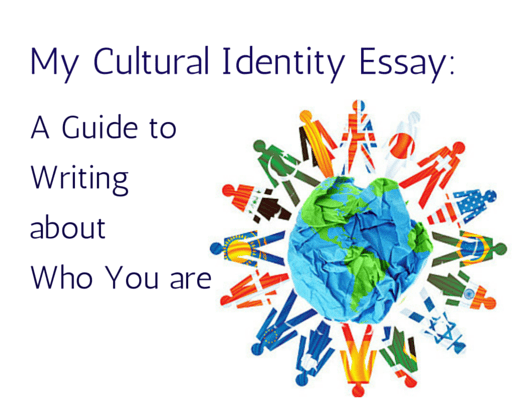
October 12, 2015
A cultural identity essay is a paper that you write exploring and explaining how your place of upbringing, ethnicity, religion, socio-economic status, and family dynamics among other factors created your identity as a person. Even facts such as what activities you took part in as a child can be part of your cultural identity. Your culture identity is ultimately the group of people that you feel that you identify with. The thought process behind this is known as cultural identity theory. To get a better idea of this, take a look at this single paragraph blurb of information that you might see in a culture identity essay. After reading, you can easily write my paper and feel comfortable getting grades as high as you can imagine.
Tired of searching something you need reading blogs? We care about your time and money! Use this 15% OFF Discount on any service you need and save your time now!
I was born in rural Missouri, but my family moved to St. Louis before I was a year old. My mother is 100 percent Irish and comes from a family that identifies very strongly with Irish culture. My father is Middle Eastern, but was adopted by an English family who moved to the United States when he was 5. We lived in a pretty big house in a subdivision. My parents had two more kids after me, they were both boys as well. My father wasn't religious, but my mom was a practicing Catholic. She went to mass every week. My brothers and I both had first communion and were confirmed, but stopped going to church as teenagers. We weren't really encouraged to play sports because our parents thought we should focus on our studies. They really emphasized math and science. I did well in these classes, but I didn't enjoy them. In high school, I became active in music and theater. Most of my friends were also into that as well. I earned a scholarship to study engineering on the East Coast, but I dropped out as a sophomore. I returned home to study music, needless to say my parents were disappointed. My brothers both pursued careers in technical fields. One is a mechanical engineer and the other is a software engineer. I am close with my family, but we do not have much in common. My circle of friends is fairly varied when it comes to race, ethnicity, religion, and economic background, but it consists almost entirely of people who are artists, musicians, writers, or people involved in those industries.
Keep in mind that your essay samples may look nothing like this. In our example, the writers choice of career, talents, and interests influenced his cultural identity more than his religious, ethnic background, or family values did. This may not be the case for you. Remember that when you are writing your paper there are no wrong answers. You just have to ask yourself insightful questions and keep the theory of cultural identity in mind as you write. Here are some questions to ask yourself:
- How did the foods I ate as a child influence my identity
- Did I look different from the kids I went to school with? How did that impact me?
- Did birth order influence who I am as an adult?
- Does my life today match the life I was raised in?

While being committed to a number of charitable causes, like volunteering at special events or giving free art lessons to children, Marie doesn’t forget her vocation – writing. She can write about almost anything but has focused on time management, motivation, academic and business writing.
Related posts

October 12 2015

Don`t have an account?
Password recovery instructions have been sent to your email
Back to Log in
Essays about Culture and Identity: 9 Examples And Prompts
Writing essays about culture and identity will help you explore your understanding of it. Here are examples that will give you inspiration for your next essay.
Culture can refer to customs, traditions, beliefs, lifestyles, laws, artistic expressions, and other elements that cultivate the collective identity. Different cultures are established across nations, regions, communities, and social groups. They are passed on from generation to generation while others evolve or are abolished to give way to modern beliefs and systems.
While our cultural identity begins at home, it changes as we involve ourselves with other groups (friends, educational institutions, social media communities, political groups, etc.) Culture is a very relatable subject as every person is part of a culture or at least can identify with one. Because it spans broad coverage, there are several interesting cultural subjects to write about.
Our culture and identity are dynamic. This is why you may find it challenging to write about it. To spark your inspiration, check out our picks of the best culture essays.
1. Sweetness and Light by Matthew Arnolds
2. how auto-tune revolutionized the sound of popular music by simon reynolds, 3. how immigration changes language by john mcwhorter, 4. the comfort zone: growing up with charlie brown by jonathan franzen, 5. culture and identity definition by sandra graham, 6. how culture and surroundings influence identity by jeanette lucas, 7. how the food we eat reflects our culture and identity by sophia stephens, 8. identity and culture: my identity, culture, and identity by april casas, 9. how america hinders the cultural identity of their own citizens by seth luna, 1. answer the question, “who am i”, 2. causes of culture shock, 3. your thoughts on dystopia and utopia, 4. gender inequality from a global perspective, 5. the most interesting things you learned from other cultures, 6. the relationship between cultural identity and clothes, 7. describe your culture, 8. what is the importance of honoring your roots , 9. how can a person adapt to a new culture, 10. what artistic works best express your country’s culture, 11. how has social media influenced human interaction, 12. how do you protect the cultures of indigenous peoples, 13. are k-pop and k-drama sensations effectively promoting korea’s culture , 14. what is the importance of cultural diversity.
“… [A]nd when every man may say what he likes, our aspirations ought to be satisfied. But the aspirations of culture, which is the study of perfection, are not satisfied, unless what men say, when they may say what they like, is worth saying,—has good in it, and more good than bad.”
Arnolds compels a re-examination of values at a time when England is leading global industrialization and beginning to believe that greatness is founded on material progress.
The author elaborates why culture, the strive for a standard of perfection, is not merely driven by scientific passions and, more so, by materialistic affluence. As he esteems religion as “that voice of the deepest human experience” to harmonize men in establishing that ideal society, Arnolds stresses that culture is the effort to “make reason and the will of God prevail” while humanizing gained knowledge to be society’s source of “sweetness and light.”
“Few innovations in sound production have been simultaneously so reviled and so revolutionary. Epoch-defining or epoch-defacing, Auto-Tune is indisputably the sound of the 21st century so far.”
Reynolds shows how Auto-Tune has shaped a pop music genre that has cut across cultures. The article maps out the music landscape Auto-Tune created and examines its impact on the culture of song productions and the modern taste for music. While the author debunks accusations that Auto-Tune destroyed the “natural” process of creating music, he also points out that the technology earned its reverence with big thanks to society’s current custom of using technology to hide blemishes and other imperfections.
Looking for more? Check out these essays about culture shock .
“… [T]he heavy immigration that countries like Italy are experiencing will almost certainly birth new kinds of Italian that are rich with slang, somewhat less elaborate than the standard, and… widely considered signs of linguistic deterioration, heralding a future where the “original” standard language no longer exists.”
American linguist McWhorter pacifies fears over the death of “standard” languages amid the wave of immigration to Europe. On the contrary, language is a vital expression of a culture, and for some, preserving is tantamount to upholding a cultural standard.
However, instead of seeing the rise of new “multiethnolects” such as the Black English in America and Kiezdeutsch in Germany as threats to language and culture, McWhorter sees them as a new way to communicate and better understand the social groups that forayed these new languages.
“I wonder why “cartoonish” remains such a pejorative. It took me half my life to achieve seeing my parents as cartoons. And to become more perfectly a cartoon myself: what a victory that would be.”
This essay begins with a huge fight between Franzen’s brother and father to show how the cultural generation gap sweeping the 60s has hit closer to home. This generation gap, where young adults were rejecting the elders’ old ways in pursuit of a new and better culture, will also be the reason why his family ends up drifting apart. Throughout the essay, Franzen treads this difficult phase in his youth while narrating fondly how Peanuts, a pop culture icon at the time, was his source of escape.
“…Culture is… your background… and Identity is formed where you belong to… Leopold Sedar Senghor and Shirley Geok-Lin Lim both talks about how culture and identity can impact… society…”
In this essay, Graham uses “To New York” by Senghor and “Learning To Love America” by Lim as two pieces of literature that effectively describe the role of culture and identity to traveling individuals.
The author refers to Sengho’s reminder that people can adapt but must not forget their culture even if they go to a different place or country. On the other hand, Lim discusses immigrants’ struggle to have double identities.
“Culture is something that surrounds all of us and progress to shape our lives every day… Identity is illustrated as the state of mind in which someone or something distinguishes their own character traits that lead to determining who they really are, what they represent.”
Lucas is keen on giving examples of how his culture and surroundings influence an individual’s identity. She refers to Kothari’s “If you are what you eat, then what am I?” which discusses Kothari’s search for her identity depending on what food she eats. Food defines a person’s culture and identity, so Kothari believes that eating food from different countries will change his identity.
Lucas also refers to “Down These Mean Streets” by Piri Thomas, which argues how different cultural and environmental factors affect us. Because of what we encounter, there is a possibility that we will become someone who we are not.
“What we grow is who we are. What we buy is who we are. What we eat is who we are.”
Stephens’ essay teaches its readers that the food we grow and eat defines us as a person. She explains that growing a crop and harvesting it takes a lot of effort, dedication, and patience, which mirrors our identity.
Another metaphor she used is planting rice: it takes skills and knowledge to make it grow. Cooking rice is more accessible than cultivating it – you can quickly cook rice by boiling it in water. This reflects people rich in culture and tradition but who lives simpler life.
“Every single one has their own unique identity and culture. Culture plays a big role in shaping your identity. Culture is what made me the person I am today and determines who or what I choose to associate myself with.”
Casas starts her piece by questioning who she is. In trying to learn and define who she is, she writes down and describes herself and her personality throughout the essay. Finally, she concludes that her culture is a big part of her identity, and she must understand it to understand herself.
“When it comes to these stereotypes we place on each other, a lot of the time, we succumb to the stereotypes given to us. And our cultural identity is shaped by these expectations and labels others give us. That is why negative stereotypes sometimes become true for a whole group or community.”
In this essay, Luna talks about how negative stereotyping in the United States led to moral distortion. For example, Americans are assumed to be ignorant of other countries’ cultures, making it difficult to understand other people’s cultures and lifestyles.
She believes that stereotyping can significantly affect an individual or group’s identity. She suggests Americans should improve their intellectual competence by being sensitive to other people’s cultures.
14 Prompts on Essays about Culture and Identity
You can discuss many things on the subject of culture and identity. To give you a starting point, here are some prompts to help you write an exciting essay about culture.
If you are interested in learning more, check out our essay writing tips and our round-up of the best essay checkers .
Understanding your personality is vital since continuous interaction with others can affect your personality. Write about your culture and identity; what is your personality? How do you define yourself? Everyone is unique, so by writing an essay about who you are, you’ll be able to understand why you act a certain way and connect with readers who have the same values.
Here’s a guide on writing a descriptive essay to effectively relay your experience to your readers.
Sometimes, people need to get out of their comfort zone and interact with other individuals with different cultures, beliefs, or traditions. This is to broaden one’s perspective about the world. Aside from discussing what you’ve learned in that journey, you can also focus on the bits that shocked you.
You can talk about a tradition or value that you found so bizarre because it differs from your culture. Then add how you processed it and finally adapted to it.

Dystopia and Utopia are both imagined worlds. Dystopia is a world where people live in the worst or most unfavorable conditions, while Utopia is the opposite.
You can write an essay about what you think a Dystopian or Utopian world may look like, how these societies will affect their citizens, etc. Then, consider what personality citizens of each world may have to depend on the two worlds’ cultures.
Today, more and more people are fighting for others to accept or at least respect the LGBTQ+ community. However, countries, territories, and religions still question their rights.
In your essay, you can talk about why these institutions react the way they do and how culture dictates someone’s identity in the wrong way. Before creating your own, feel free to read other essays and articles to learn more about the global gender inequality issue.
The world has diverse cultures, traditions, and values. When you travel to a new place, learning and writing about your firsthand experiences with unique cultures and rituals will always be an interesting read.
In this prompt, you’ll research other cultures and how they shaped their group’s identity. Then, write about the most exciting aspects you’ve learned, why you found them fascinating, and how they differ from your culture.
Those proud of their culture will wear clothes inspired by them. Some wear the same clothes even if they aren’t from the same culture. The debate over cultural appropriation and culture appreciation is still a hot topic.
In this essay, you may start with the traditions of your community or observances your family celebrates and gathers for. Then, elaborate on their origins and describe how your community or family is preserving these practices.
Learning about your roots, ancestors, and family cultures can help strengthen your understanding of your identity and foster respect for other cultures. Explore this topic and offer examples of what others have learned. Has the journey always been a positive experience? Delve into this question for an engaging and interesting essay.
When a person moves country, it can be challenging to adapt to a new culture. If there are new people at work or school, you can interview them and ask how they are coping with their new environment. How different is this from what they have been used to, and what unique traditions do they find interesting?
Focus on an art piece that is a source of pride and identity to your country’s culture, much like the Tinikling of the Philippines or the Matryoshka dolls of Russia. Explore its origins and evolution up to its current manifestation and highlight efforts that are striving to protect and promote these artistic works.
The older generation did not have computers in their teen years. Ask about how they dated in their younger years and how they made friends. Contrast how the younger generation is building their social networks today. Write what culture of socialization works better for you and explain why.
Take in-depth navigation of existing policies that protect indigenous peoples. Are they sufficient to serve these communities needs, and are they being implemented effectively? There is also the challenge of balancing the protection of these traditions against the need to protect the environment, as some indigenous practices add to the carbon footprint. How is your government dealing with this challenge?
A large population is now riding the Hallyu or the Korean pop culture, with many falling in love with the artists and Korea’s food, language, and traditional events. Research how certain Korean films, TV series, or music have effectively attracted fans to experience Korea’s culture. Write about what countries can learn from Korea in promoting their own cultures.
Environments that embrace cultural diversity are productive and innovative. To start your essay, assess how diverse your workplace or school is. Then, write your personal experiences where working with co-workers or classmates from different cultures led to new and innovative ideas and projects. Combine this with the personal experiences of your boss or the principal to see how your environment benefits from hosting a melting pot of cultures.
If you aim for your article to effectively change readers’ perspectives and align with your opinion, read our guide to achieving persuasive writing .

Aisling is an Irish journalist and content creator with a BA in Journalism & New Media. She has bylines in OK! Magazine, Metro, The Inquistr, and the Irish Examiner. She loves to read horror and YA. Find Aisling on LinkedIn .
View all posts
My Cultural Identity
This essay about my culture explores the unique blend of Eastern European heritage and northeastern United States customs that define my cultural identity. It discusses how cuisine serves as a vital cultural expression, blending traditional dishes with local flavors to create a rich tapestry of food that marks both familial and festive gatherings. The essay also touches on the role of language, noting how Polish and Ukrainian phrases permeate family conversations, preserving the linguistic heritage of my ancestors. Additionally, it describes the influence of the local environment on community activities that are deeply intertwined with the changing seasons, reflecting a strong connection to both place and tradition. Finally, the essay highlights core values such as hard work, resilience, and the importance of education, which have been inherited from immigrant ancestors and remain central to my cultural ethos today. Overall, the essay paints a picture of a dynamic cultural identity that merges historical legacies with contemporary life.
How it works
The journey into one’s cultural realm is a labyrinthine expedition, traversing the intricacies of personal and collective identity. It entails an immersion into the labyrinth of traditions, ethos, and societal mores that thread through generations, etching indelible imprints upon the psyche and conduct of individuals within a social milieu. Contemplating the inquiry, “What defines my cultural essence?” compels me to navigate through a mosaic of historical legacies, geographical contexts, and socio-cultural landscapes that delineate my distinct cultural tapestry.
At its nucleus, my cultural ethos embodies an amalgamation of indigenous norms from the northeastern expanse of the United States and the inherited legacies of Eastern European forebears.
This fusion bequeaths a singular modus vivendi that exalts the fortitude of immigrant enclaves juxtaposed against the whirlwind of innovation characterizing contemporary American ethos. The cultural ethos, encapsulated within gastronomic delights, festive revelries, and oral traditions, serves as a testament to the resilience of diasporic narratives amidst the currents of adaptation and assimilation.
The culinary arena emerges as a palpable terrain of cultural expression, where ancestral lore converges with contemporary culinary sensibilities. The hearth becomes a crucible where ancestral legacies intermingle with contemporary innovations, engendering a palimpsest of flavors that narrate tales of diasporic odyssey. Holiday repasts bear witness to this cultural communion, wherein quintessential American fare harmonizes with Eastern European delicacies such as pierogi and borscht, each culinary creation a testament to the odyssey of migration and acculturation.
Language, with its vernacular cadences and idiomatic lexicon, constitutes a linchpin of my cultural identity. While English serves as the lingua franca of quotidian discourse, vestiges of Slavic linguistic heritage punctuate familial colloquy, particularly in matters pertaining to culinary alchemy and familial camaraderie. Though the younger generation may not wield these linguistic nuances fluently, they serve as mnemonic vestiges of ancestral provenance, kindling sentiments of pride and nostalgia amidst familial communion.
Community life serves as a tableau vivant, wherein the seasonal vicissitudes of nature choreograph communal rites and festivities. Residing in locales where seasonal transitions orchestrate the cadence of daily life, communal engagements are inextricably intertwined with the flux of natural cycles: autumnal revelries, winter frolics, vernal rejuvenation, and summertime sojourns to coastal enclaves. Each season bequeaths its pantheon of rituals and festivities, many of which are testament to the adaptive ingenuity of diasporic communities in synchronizing ancestral legacies with local landscapes.
Furthermore, my cultural ethos is imbued with a valorization of toil, tenacity, and the pursuit of knowledge. These cardinal virtues, bequeathed by predecessors who traversed oceans in pursuit of greener pastures, reverberate resoundingly within our family’s ethos, shaping our approach towards life’s vicissitudes and aspirations. Manifesting in a reverence for scholastic pursuits and vocational pursuits, these values mirror the broader American zeitgeist of ambition and individual endeavor.
In summation, my cultural identity emerges as a symphony of epochs, a confluence of bygone legacies and emergent narratives. It is characterized by a variegated epicurean repertoire, a polyglot linguistic mosaic, a tapestry of communal conviviality, and an ethos steeped in ancestral wisdom and aspirational verve. The odyssey of exploring and articulating the intricacies of my cultural ethos not only engenders a profound rapport with ancestral moorings but also fosters a heightened appreciation for the kaleidoscopic diversity enshrined within the tapestry of global cultures.
Cite this page
My Cultural Identity. (2024, Apr 22). Retrieved from https://papersowl.com/examples/my-cultural-identity/
"My Cultural Identity." PapersOwl.com , 22 Apr 2024, https://papersowl.com/examples/my-cultural-identity/
PapersOwl.com. (2024). My Cultural Identity . [Online]. Available at: https://papersowl.com/examples/my-cultural-identity/ [Accessed: 27 Apr. 2024]
"My Cultural Identity." PapersOwl.com, Apr 22, 2024. Accessed April 27, 2024. https://papersowl.com/examples/my-cultural-identity/
"My Cultural Identity," PapersOwl.com , 22-Apr-2024. [Online]. Available: https://papersowl.com/examples/my-cultural-identity/. [Accessed: 27-Apr-2024]
PapersOwl.com. (2024). My Cultural Identity . [Online]. Available at: https://papersowl.com/examples/my-cultural-identity/ [Accessed: 27-Apr-2024]
Don't let plagiarism ruin your grade
Hire a writer to get a unique paper crafted to your needs.

Our writers will help you fix any mistakes and get an A+!
Please check your inbox.
You can order an original essay written according to your instructions.
Trusted by over 1 million students worldwide
1. Tell Us Your Requirements
2. Pick your perfect writer
3. Get Your Paper and Pay
Hi! I'm Amy, your personal assistant!
Don't know where to start? Give me your paper requirements and I connect you to an academic expert.
short deadlines
100% Plagiarism-Free
Certified writers
99 Cultural Identity Essay Topics & Examples
Our experts have gathered identity essay topics that you can research or discuss in a class. See the list and find the perfect title here!
🏆 Best Cultural Identity Topic Ideas & Essay Examples
💡 interesting identity essay titles, 👍 good essay topics on cultural identity, ❓ research questions about cultural identity.
In high school or college, you might be assigned to write a cultural identity essay. Topics on the subject are quite easy to find, given that culture surrounds us everywhere we go. However, choosing one relevant idea can become an issue. Are you going to discuss an American or Canadian identity essay title? Or are you willing to talk about the history of pop culture around the globe? In either case, this article will be helpful for you.
- Cultural Identity Theory: “How to Be Chinese” by Celeste Ng Thus, while recognizing the role that the specified cultural signifiers have for Asian American people in their attempts to retain their cultural identity, Ng also demonstrates the urge to introduce immediate change to prevent the […]
- How Does Culture Affect the Self Identity Personal Essay The economic background, family relations and ethnic distinctions have contributed significantly to the personality trait of being a low profile person who is considerate of others.
- Hall Stuart: Questions of Cultural Identity Hall states that it is important to theorize the notion of identity to make it more applicable. However, Hall still claims that it is important to understand what identity is.
- Cultural Identity and Heritage in the “Everyday Use” by Alice Walker In the broad context, Walker designs the story to underscore the conflict that African Americans faced concerning their cultural identity and heritage after the abolition of slavery.
- Cultural Identity: Problems, Coping, and Outcomes The intensification of the processes of globalization, cultural integration, and expansion of contacts between representatives of different countries led to the gradual blurring of boundaries between national cultures and the loss of cultural identity.
- Racial and Cultural Identity Development Model At the stage of dissonance, a person is in a conflict between group-appreciating and depreciating within the attitude toward self as well as in a conflict between the emotions of shared experiences and group-depreciating views […]
- What Role Does Food Play in Cultural Identity? From the point of view of cultural studies, such a model of nutrition speaks more about the absence of global roots, the absence of deep moral guidelines, and not about the convenience of the process.
- Cultural Identity in “White Teeth” by Zadie Smith Exploring the thematic significance of the novels title “White Teeth” it would be instrumental to argue that the title touches on the aspects of cultural identity.
- Migration, Identity and Multiculturalism Equity in Ethnic Policy In the earlier years, discriminative policies had been enacted but the mid of the last century saw the eradication of these policies and the establishment of better ones that addressed the […]
- Cultural Borrowing: Ethnic Fashion Obscures Cultural Identity I write this article from the larger perspective of what kind of cultural items can be borrowed and the benefits of the same and at the same time the tendency to obviate the subtext.
- Cultural Influences on Personality The basis of Indonesian culture and its ability to comply with a fixed standard, regulation, or requirement of societal norms is the importance put on honor and respect for the individual. This is a keystone […]
- Cultural Identity: the Position in Society Here, the answer is “yes, I am” and the answer to this question is quite accurate in terms of the majority of the Arabic people.
- Australia: Being a Multicultural Society It is reported the between 2000 and 2005, there was significant public concern within the country due to the role of detention centers in the country.
- Cultural Identity: “Everyday Use” by Alice Walker One of the instances of elements of life associated with identity is music. As such, blues music is not particularly popular throughout America, yet it remains a significant part and a distinctive aspect of the […]
- Cultural Identity and Justice in Early Learning Space One of the myths that interfere with the ability to talk about race and racism in early care and education settings is associated with the position that children do not see races.
- Transcending National and Cultural Identity Despite the Odds The success of Shakira in terms of her music is the first real evidence that a single individual can maintain multiple cultures and nationalities.
- Art Education Preserving Ethno Cultural Identity The image presents a fantasy of how sweet their fries and chicken are, and for some reason, some customers visit the place for the first time due to the visual art available.
- The Crisis of Cultural Identity of Luxembourg Due to Massive Immigration The possibility of a city-wide display exhibiting the workmanship and specialties of Luxembourg could be a method for opening the secret of the nation’s way of life. There is an incredible blend of individuals who […]
- Strong Cultural Identity Importance in Amy Tan’s “Fish Cheeks” She communicates with her audience in a playful manner, with the use of rhetorical techniques such as irony and hilarious analogies, to better illustrate her point.
- Arabic Cultural Identity: Sonallah Ibrahim His writing is also a constant reminder of the failures of the governments in standing up to the expectations of the Egyptian citizens.
- Malay Muslim Traditions and Cultural Identity First I clearly expected that it if the parents and close family members who convey the identity to their children stayed together, then the conflict between mainstream expectations in the American way of life and […]
- Gendered Cultural Identity and Globalization in Canada It should be well understood that the escalation of politics of cultural identities in Canada is a result of the background of the cultural nationalism that came before it.
- Cultural Identity vs. Ethnic Fashion A part of the modern lifestyle that looks hip and very happening without actually understanding the real meaning of the cultural item as it pertains to the ethnicity of the person.
- Asian Cultural Identity: Interview It will explore the individual’s definition of cultural identity, his family origin, most important cultural values, factors that contributed towards the development of cultural identity, and the interaction between the self and cultural identity.
- African-American Cultural Identity’ and Values’ Critique Despite the high levels of discrimination, they got themselves out of the slavery of writing for the whites by mastering the Anglo-American traditions.
- Cultural Differences: Individualism vs. Collectivism The understanding of the relevant cultures helps in knowing where the people around us originate. The religion types are unique to the areas where they are found and exemplify the culture of people who participate […]
- Cultural Diversity in Society: Reforms to the Way a Society Is Conducted The concepts of the diversity of the US culture that are shared in this article are important as they are address different elements of a culture that are important when it comes to determining how […]
- Social Identity in Social Psychology This essay shall use the movie, Grand Illusion to identify and explore three bases of group categorisation and apply social identity theories in order to explain whether the characters transcend or exposed to illusion in […]
- Culture and Self: Cultural Specifics Although both authors provide a fairly detailed account of the way in which cultural background and the development of self are intertwined, the latter research seems to focus on the application of the findings related […]
- Social Constructionism and Its Impact on Cultural Identity in a Society Ruled by a Strong Rhetoric of Risk and Health and Safety Regulations These include social constructionism, namely the development of this theoretical framework and how it relates to the view of the self using accountability as an example; the rise of the dominant discourse on health and […]
- Multicultural Psychology: Cultural Identity and Racism It is a branch of psychology that tries to comprehend and represent the psychology of different people, groups and organizations adequately for the purpose of equal treatment due to the fact that there is a […]
- Influence of Cultural Identity the Way Middle School Students Learn The activities which students participate in and the interactions they have with peers, adults, and the physical characteristics of their learning environment all contribute to their motivation to learn and desire to engage.
- Issues of Japanese Cultural Identity The other way the anime productions deal with the issues of the Japanese and their cultural identity is by presenting the aspects and ideas that define the people of Japan.
- The Influence Of Modernity And Globalization On Cultural Identity
- The Family Tradition of Making a Huge Batch of Ravioli as a Cultural Identity
- Cultural Identity Of The Black Native, And Their Subsequent
- Racial Cultural Identity Developement Model
- The Importance of Cultural Identity and Socialization in Education
- Cultural Identity, Mobility, and Decentralization
- Maintaining Cultural Identity in the Face of Adversity
- The Effects Of Perceived Brand Globalness And Local Iconness On Brand Prestige And Perceived Quality: The Role Of Consumers’ Cultural Identity
- Cultural Identity and Intercultural Communication
- The Importance of Positive Cultural Identity
- Changes of Cultural Identity
- An Analysis of the Difficulties of Establishing a Cultural Identity for the United States of America
- The Cultural Identity Within Asian Writing Systems
- Cross-Linguistic and Cross-Cultural Identity
- The Connection Between Food Study and Cultural Identity
- Individuals Learn Of Cultural Identity Through The Acculturation Process
- An Exploration of Cultural Identity in Hamlet by William Shakespeare
- The Impact of Globalization to Cultural Identity
- The Effects of Language Extinction on Cultural Identity in Third World Countries
- The Harlem Renaissance and a New Cultural Identity
- Intercultural Communications and Cultural Identity
- Maintaining Cultural Identity In Design
- Importance Of Cultural Identity And Diaspora
- Multicultural Counseling and Cultural Identity Analysis
- Meaning of Life and Australian Cultural Identity
- Popular Music, Gender, Sexuality, and Cultural Identity
- A Look at the Cultural Identity in The Song of Solomon by Toni Morrison
- The Influence of Cultural Identity on Willingness to Pay Values in Contingent Valuation Surveys
- Self Awareness and Cultural Identity
- The Era Of New And Improved Cultural Identity
- An Interpretive Ethnographic Perspective on Negotiating and Leveraging Cross-Cultural Identity
- The Confiscation of Cultural Identity in North America
- The White Power Structure And Cultural Identity
- Cultural Identity Through Local Advertisement
- What Are The Most Important Parts Of Cultural Identity?
- An Analysis of Cultural Identity in Genre Films
- The Cultural Differences Between China and America
- The Differences (or Similarities) Between Ethnic identity, Cultural identity, and Acculturation
- Evaluating Cultural Identity Using Caryl Phillips Cambridge
- The Formation of Nation-State and Cultural Identity: A Georgian Perspective
- An Analysis of the Issue of Cultural Identity and the Cinematic Representation
- Did Americans Find Their Cultural Identity on the Eve of the Revolution?
- Do Cultural Identity and Understanding Influence Health Equity?
- Does Heritage Impact Culture Identity?
- Does Social Media Influence Cultural Identity?
- How Do You Maintain Your Cultural Identity?
- How and Why Does Culture Identity Affect the Idea of ‘Beauty’?
- How Cultural Identity and Understanding Influence Health?
- How Not Lose Your Cultural Identity While Living in a New Country?
- How Does Cultural Identity Impact American Culture?
- How Many Types of Cultural Identity Are There?
- How Does Art Embody Cultural Identity?
- Who Created the Cultural Identity Theory?
- Why Is Cultural Identity Important to Us?
- Why Is Cultural Identity Hard to Define?
- What Defines India’s Cultural Identity?
- What Is the Main Idea of Cultural Identity?
- Where Does Cultural Identity Reside?
- What Are the Most Important Parts of Your Cultural Identity?
- What Are the Different Types of Cultural Identity?
- What Is Cultural Identity Development?
- What Are the Three Different Types of Identity?
- What Are Aspects of Cultural Identity?
- What Does Culture Identity Mean in Literature?
- What Are the Levels of Cultural Identity?
- What Is the Difference Between Cultural Identity and Identity?
- Chicago (A-D)
- Chicago (N-B)
IvyPanda. (2023, December 21). 99 Cultural Identity Essay Topics & Examples. https://ivypanda.com/essays/topic/cultural-identity-essay-examples/
"99 Cultural Identity Essay Topics & Examples." IvyPanda , 21 Dec. 2023, ivypanda.com/essays/topic/cultural-identity-essay-examples/.
IvyPanda . (2023) '99 Cultural Identity Essay Topics & Examples'. 21 December.
IvyPanda . 2023. "99 Cultural Identity Essay Topics & Examples." December 21, 2023. https://ivypanda.com/essays/topic/cultural-identity-essay-examples/.
1. IvyPanda . "99 Cultural Identity Essay Topics & Examples." December 21, 2023. https://ivypanda.com/essays/topic/cultural-identity-essay-examples/.
Bibliography
IvyPanda . "99 Cultural Identity Essay Topics & Examples." December 21, 2023. https://ivypanda.com/essays/topic/cultural-identity-essay-examples/.
- Civil Rights Movement Questions
- Social Democracy Essay Titles
- Culture Topics
- Social Responsibility Topics
- Personality Development Ideas
- Social Development Essay Topics
- Emotional Development Questions
- Social Work Essay Titles
- Cognitive Development Essay Ideas
- Human Development Research Ideas
- Personal Identity Paper Topics
- Moral Development Essay Topics
- Cultural Competence Research Topics
- Oppression Research Topics
- Ethnocentrism Topics
What is Cultural Identity and Why is it Important?
- by Victoria Wilson
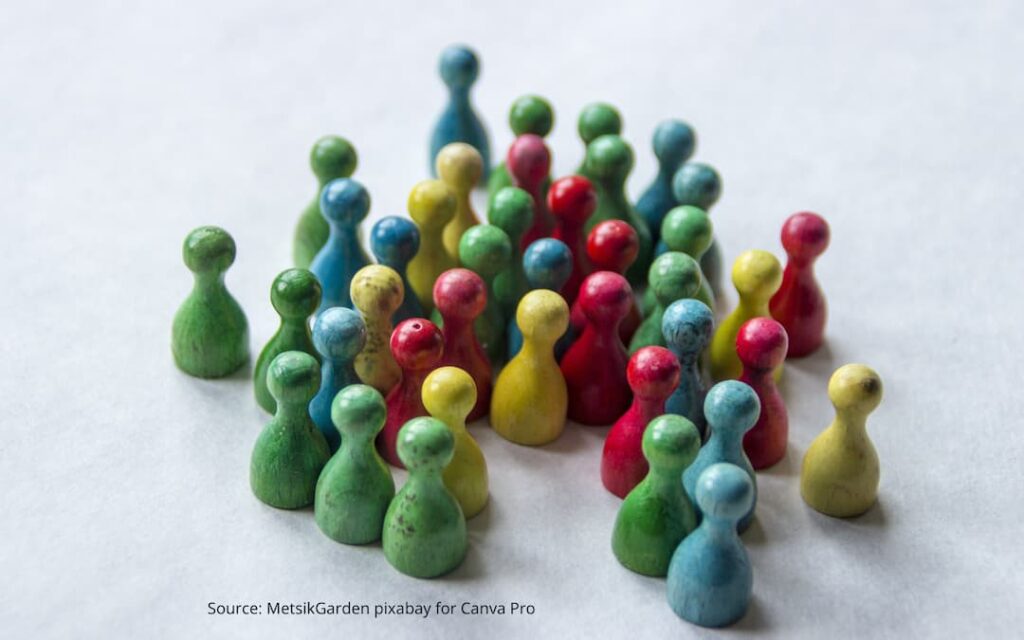
If you have ever found yourself baffled by someone’s response to a situation, you have seen the effects of cultural identity. This can be especially perplexing when the situation seems benign to you, but the other person has an extremely negative or positive response. But what is cultural identity and why does it matter?
Culture, in this context, refers to the beliefs, norms, behaviors, and values that a given group of people deem acceptable. Whereas identity is about knowing what is acceptable and true for yourself. We form a cultural identity when we subconsciously interpret and incorporate signals from the world around us into our own identity so we can belong. Therefore:
Your cultural identity is a critical piece of your personal identity (and worldview) that develops as you absorb, interpret, and adopt (or reject) the beliefs, values, behaviors, and norms of the communities in your life.
Our cultural identity can evolve, as culture is ever-evolving and dynamic. And while there are people who progress through life without ever thinking about their cultural identity, it is something we tend to become aware of when it’s challenged. This typically happens when we find ourselves in parts of the world or among groups with different cultural norms. Our cultural identity is important because it influences how we interpret and react to such situations, which can affect how successful we are in life.
What Defines and Shapes a Person’s Cultural Identity?
Anytime a group of people unites toward a common objective, a culture begins to form. No matter how large or small the group, there are beliefs, norms, values, and behaviors that emerge.
What makes culture complicated is that many of these defining characteristics go unspoken. The group unconsciously develops certain standards for what is normal and acceptable based on social cues. Then, through our continual exposure to the group, we begin to accept these standards as part of our cultural identity.
Important parts of your cultural identity are shaped due to your affiliation with any number of groups or cultural patterns, some of which we (as a culture) assign to you at birth, such as your:
- family of origin
- local community
- physical ability
- nationality

Other contributions to your cultural identity occur as you navigate your life and the social constructs (aka social constructions) around you. As you have experiences or develop skills and interests, you join and leave certain communities because you have or lack commonality with their group members. As your life unfolds, you may become involved with many groups including:
- educational institutions
- professional organizations
- social clubs
- online communities
- political or special interest groups
- support groups
To complicate matters further, certain situations and contexts provide an additional filter that allows unique elements of your cultural identity to emerge. For example, if you were born to a family that encouraged you to go to college and pursue a career in science, you might accept this path, join the physics club, and absorb the standards of that group into your own identity. This is completely normal. Humans are social animals, which means we depend on each other for survival. It’s natural, even necessary , for us to seek a sense of belonging and to look for cultural groups who will accept us for who we are. The challenge arises when we become so fixated on gaining status with our groups that we fail to notice when they aren’t serving us or resist opportunities that arise.
Myths Around Cultural Identity
I often encounter three big myths about cultural identity in my work with clients. And I find that it is critical that we identify and address these myths before my client is ready to move forward.
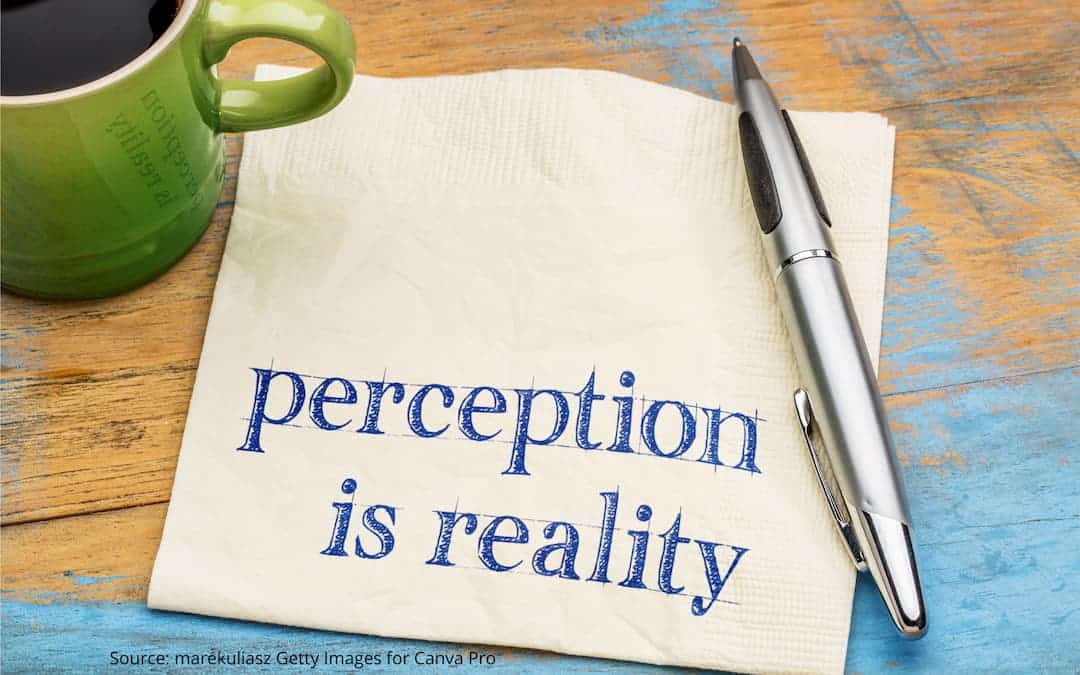
The first myth is that our cultural identity is fixed, which simply isn’t true. It is dynamic and it evolves as we affiliate ourselves with different groups. Think about some of the beliefs you had as a child that have since changed. This happens due to our exposure to new ways of thinking and as we absorb whatever resonates for us into our cultural identity.
The second myth I often hear is that some of us don’t have a cultural identity at all. The reality is that everyone has one. However, many of us are unaware of our own cultural identity and how it influences every single aspect of our life.
The final, and perhaps most dangerous myth, is that our own cultural identity is mainstream, i.e., many of us believe we interpret situations the same way others do. When this is the case, our desire to understand the world can result in the creation of mental shortcuts that influence how we interact with someone who has a cultural identity that’s different from ours.
The danger of these shortcuts is that they can lead to generalizing and stereotyping. When this occurs, we prejudge people as “friend or foe,” the latter of which can trigger a “fight or flight” response and cripple our ability to have meaningful, healthy, and productive interactions.
When I work with clients, I help them unravel their assumptions about what is normal, right, and true for them. But before we can get to work, it’s important that they understand the strength of cultural influences and how they shape our worldview so they can begin to recognize them in their own life and challenge them as they make decisions about their futures.
Why is Cultural Identity Important?
Our cultural identity influences how we interpret and react to situations, so it is important that we become aware of our own identity in relation to the world around us. Since we have an innate craving to feel a sense of belonging to a group, when we are under stress we tend to subconsciously revert to whatever behaviors make us “feel” safe and accepted. In doing so, we set up invisible barriers within ourselves and between ourselves and others that impact personal interactions, professional performance, and organizational success .
In my professional life, I’ve seen conflicts arise due to fundamentally different viewpoints and a lack of understanding about the effect of cultural identities. When we develop an awareness of how our identities can act as a catalyst or barrier for growth, we unlock our true potential.
There may also be times in our lives when our own cultural identity comes into conflict with what we encounter in the world around us or what we feel within ourselves to be true. For instance, the person who pursued a career in science (from our example earlier) might eventually have this experience because instead of finding a career path that felt right to them , they did what their family expected of them. This tension, which is often called a cultural identity crisis, can create discomfort and even distress.
How to Cope With a Cultural Identity Crisis
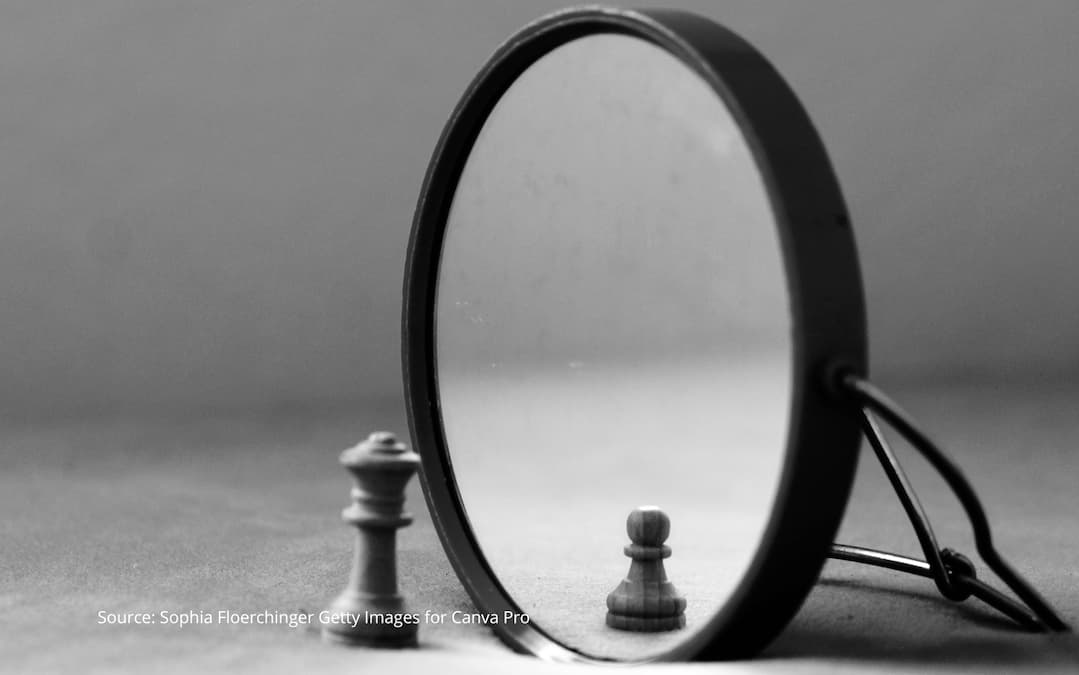
Should you experience a cultural identity crisis, you may feel a natural tendency to ignore or blame other factors for the conflict. However, it is important to pay attention to yourself and to examine the cultural conditioning that formed your cultural identity in the first place. Here are three things you can do to begin this process:
- Pause and begin building your awareness around your own cultural identity. Our Identifying Your Cultural Contributors worksheet can help you get started.
- How has my cultural identity affected my reaction to this situation?
- What influencers have contributed to building my identity in relation to this situation?
- Does my cultural identity truly reflect the person I want to be going forward?
- If the tension is with another person, try looking at things from their perspective. What influencers and cultural contributors might have impacted the way the other person is approaching the situation?
- Finally, come up with 1-2 actionable steps to address the situation, then commit to reflecting on your own identity regularly. This could be as simple as taking 5-10 minutes each month to revisit the worksheets listed above and considering how any new groups in your life (such as new social groups or a change in employment) are contributing to the growth and evolution of your identity.
The Bottom Line
Your cultural identity is critical to your success because it influences the way you interpret and react to the world around you. Building an awareness of your identity can help you gain a better understanding of the unique contributions you have to offer, both personally and professionally while shedding light on your blind spots. For additional insight, we’d invite you to visit our resources page for more exercises.
Share this post:
About the author.

Victoria Shiroma Wilson, Ed.D., P.C.C.
Victoria Shiroma Wilson, Ed.D., P.C.C., is the founder of Exceptional Futures, a provider of frameworks that help people tap into the power of their cultural identities to answer some of life’s biggest questions. Victoria is on the teaching faculty at Duke University and earned her doctoral degree in Global Leadership from the University of Southern California, a master’s degree in Psychology from Santa Clara University, and a master’s degree in Asian Studies from the University of Pennsylvania.
Related Posts

How to Change Your Life for the Better

What is Herd Mentality and How Does It Affect Us?

Embracing the Visionary Idealist
Exceptional connections, sign up for our inflection point newsletter:.

Contact | Privacy Policy | Terms & Conditions
Privacy Overview
10 questions to transformation, download our guide to build your awareness about what is important to you and insights into your next steps., discover your identity, download our workbook to gain insight into the aspects of your identity that make you unique., free download, download our workbook to gain clarity and perspective about your job and the next steps in your career., get the arrival fallacy worksheet to explore these tips in more depth..
Understanding Cultural Diversity and Diverse Identities
- Living reference work entry
- First Online: 10 November 2019
- Cite this living reference work entry

- Cong Lin 7
Part of the book series: Encyclopedia of the UN Sustainable Development Goals ((ENUNSDG))
1809 Accesses
6 Citations
1 Altmetric
Cross-cultural communication ; Dialogue ; Multiculturalism ; Pluralism
Definitions
Cultural diversity is a debatable, open-ended term, which generally refers to a reality of coexistence of diverse knowledge, beliefs, arts, morals, laws, customs, religions, languages, abilities and disabilities, genders, ethnicities, races, nationalities, sexual orientations, etc., of human beings. It could extend to the way people react to this reality and the way people choose to live together with this reality.
Cultural Diversity and Identity
Introduction.
People are divided by several factitious categories and partitions, such as identity politics, around the world where all cultural groups feel their members are to some extent being attacked, bullied, persecuted, and discriminated against. Whether people admit it or not, and whether government hide it or not, it is a fact that people are full of diversity in terms of gender, social class, ethnicity, race, language, abilities and disabilities,...
This is a preview of subscription content, log in via an institution to check access.
Access this chapter
Institutional subscriptions
Banks JA (2008a) Diversity, group identity, and citizenship education in a global age. Educ Res 37(3):129–139
Article Google Scholar
Banks JA (2008b) An introduction to multicultural education. Pearson, Boston
Google Scholar
Banks JA (2012) Ethnic studies, citizenship education, and the public good. Intercult Educ 23(6):467–473
Barry BM (2001) Culture and equality: an egalitarian critique of multiculturalism. Harvard University Press, Cambridge
Besley T, Peters MA, Xaioping J (2011) Interculturalism, ethnocentrism and dialogue. Policy Futures Educ 9(1):1–12
Bingham CW (2001) Schools of recognition: identity politics and classroom practices. Rowman & Littlefield Publishers, Lanham
Darling-Hammond L, French J, Garcia-Lopez SP (2002) Learning to teach for social justice. Teachers College Press, New York/London
Dilg M (1999) Race and culture in the classroom: teaching and learning through multicultural education. Teachers College Press, New York/London
Dixon K (1977) Is cultural relativism self-refuting? Br J Sociol 28(1):75–88
English AR (2016) Dialogic teaching and moral learning: self-critique, narrativity, community and ‘blind spots’. J Philos Educ 50(2):160–176
Evans N, Levinson SC (2009) The myth of language universals: language diversity and its importance for cognitive science. Behav Brain Sci 32(5):429–448
Fillmore LW (2005) When learning a second language means losing the first. In: Suarez-Orozco C, Suarez-Orozco M, Qin-Hilliard DB (eds) The new immigration: an interdisciplinary reader. Routledge, New York/London, pp 289–307
Ford RT (2005) Racial culture: a critique. Princeton University Press, Princeton
Fraser N (2003) Redistribution or recognition? A political-philosophical exchange. Verso, London/New York
Girishkumar D (2015) Multiculturalism or Interculturalism? A conversation with ted cantle. J Intercult Stud 36(6):729–735
Herskovits MJ (1972) Cultural relativism. Random House, New York
Hess D (2011) Discussions that drive democracy. Educ Leadersh 69(1):69–73
Jackson L (2014) Muslims and Islam in U.S. education: reconsidering multiculturalism. Routledge, London/New York
Book Google Scholar
Kazepides AC (2010) Education as dialogue: its prerequisites and its enemies. McGill-Queen’s University Press, Montréal
Kennedy KJ, Hue MT (2011) Researching ethnic minority students in a Chinese context: mixed methods design for cross cultural understandings. Comp Educ 47(3):343–354
Kymlicka W (1989) Liberalism, community, and culture. Clarendon Press, Oxford
Kymlicka W (1995) Multicultural citizenship: a liberal theory of minority rights. Oxford University Press, Oxford
Kymlicka W, Banting K (2006) Immigration, multiculturalism, and the welfare state. Ethics Int Aff 20(3):281–304
Langmann E (2016) My way to you: how to make room for transformative communication in intercultural education. J Philos Educ 50(2):233–245
Levinson M (2012) No citizen left behind. Harvard University Press, Cambridge
Levinson M (2016) Diversity and civic education. In: Levinson M, Campbell DE, Hess FM (eds) Making civic count: citizenship education for a new generation. Harvard Education Press, Cambridge, pp 89–114
Lin C, Jackson L (2019a) From shared fate to shared fates: an approach for civic education. Stud Philos Educ 38(5):537–547
Lin C, Jackson L (2019b) Multiculturalism in Chinese history in Hong Kong: constructing Chinese identity. Asia Pacific J Educ 39(2):209–221
Lin C, Jackson L (2019c) Politics in history education in Hong Kong: towards critical political education. Educ Stud Japan 13:39–54
Macedo S (2004) Liberalism and group identities. In: McDonough K, Feinberg W (eds) Education and citizenship in liberal-democratic societies: teaching for cosmopolitan values and collective identities. Oxford University Press, Oxford, pp 414–436
Modood T (2007) Multiculturalism: a civic idea. Polity, Cambridge
Moon S (2011) Rethinking culturally responsive teaching: toward new (Im)possibilities of curriculum studies and policy. Multicult Educ Rev 3(2):69–102
Parekh BC (2006) Rethinking multiculturalism: cultural diversity and political theory. Palgrave Macmillan, Basingstoke/New York
Putnam H (2012) Philosophy in an age of science: physics, mathematics, and skepticism. Harvard University Press, Cambridge
Rousseau JJ (1997) The social contract and other later political writings. Cambridge University Press, Cambridge/New York
Schmidt PF (1955) Some criticisms of cultural relativism. J Philos 52(25):780–791
Seglow J (2003) Neutrality and equal respect: on Charles Larmore’s theory of political liberalism. J Value Inq 37(1):83–96
Sensoy OZ, Di Angelo R (2017) Is everyone really equal? An introduction to key concepts in social justice education. Teachers College Press, New York
Servaes J (2005) Beyond differences in cultural values and modes of communication. In: Xu S, Kienpointner M, Servaes J (eds) Read the cultural other: forms of otherness in the discourses of Hong Kong’s decolonization. Mouton de Gruyter, Berlin/New York, pp 49–70
Chapter Google Scholar
Spring J (2012) Deculturation and the struggle for equality: a brief history of the education of dominated cultures in the United States. McGraw-Hill, New York
Taylor C, Gutmann A (1994) Multiculturalism: examining the politics of recognition. Princeton University Press, Princeton
Tully J (1995) Strange multiplicity: constitutionalism in an age of diversity. Cambridge University Press, Cambridge
UNESCO (2002) UNESCO universal declaration on cultural diversity: a vision, a conceptual platform, a pool of ideas for implementation, a new paradigm. United Nations Educational, Scientific and Cultural Organization, Paris
United Nations Economic and Social Council (2019) Special edition: Progress towards the sustainable development goals. Available via. https://undocs.org/en/E/2019/68 . Accessed 15 Aug 2019
Valenzuela A (1999) Subtractive schooling: U.S.-Mexican youth and the politics of caring. State University of New York Press, Albany
Williams M (2004) Citizenship as identity, citizenship as shared fate, and the functions of multicultural education. In: McDonough K, Feinberg W (eds) Education and citizenship in liberal-democratic societies: teaching for cosmopolitan values and collective identities. Oxford University Press, Oxford, pp 208–247
Yúdice G (1995) Neither impugning nor disavowing whiteness does a viable politics make: the limits of identity politics. In: Newfield C, Strickland R (eds) After political correctness. Westview Press, Boulder, pp 255–285
Download references
Author information
Authors and affiliations.
Faculty of Education, The University of Hong Kong, Hong Kong, SAR, China
You can also search for this author in PubMed Google Scholar
Corresponding author
Correspondence to Cong Lin .
Editor information
Editors and affiliations.
European School of Sustainability, Hamburg University of Applied Sciences, Hamburg, Hamburg, Germany
Walter Leal Filho
Center for Neuroscience & Cell Biology, University of Coimbra, Coimbra, Portugal
Anabela Marisa Azul
Faculty of Engineering and Architecture, Passo Fundo University Faculty of Engineering and Architecture, Passo Fundo, Brazil
Luciana Brandli
Istinye University, Istanbul, Turkey
Pinar Gökcin Özuyar
International Centre for Thriving, University of Chester, Chester, UK
Section Editor information
Centre for Global Sustainability Studies, Universiti Sains Malaysia, Penang, Malaysia
Theam Foo Ng
Rights and permissions
Reprints and permissions
Copyright information
© 2019 Springer Nature Switzerland AG
About this entry
Cite this entry.
Lin, C. (2019). Understanding Cultural Diversity and Diverse Identities. In: Leal Filho, W., Azul, A., Brandli, L., Özuyar, P., Wall, T. (eds) Quality Education. Encyclopedia of the UN Sustainable Development Goals. Springer, Cham. https://doi.org/10.1007/978-3-319-69902-8_37-1
Download citation
DOI : https://doi.org/10.1007/978-3-319-69902-8_37-1
Received : 14 August 2019
Accepted : 15 August 2019
Published : 10 November 2019
Publisher Name : Springer, Cham
Print ISBN : 978-3-319-69902-8
Online ISBN : 978-3-319-69902-8
eBook Packages : Springer Reference Earth and Environm. Science Reference Module Physical and Materials Science Reference Module Earth and Environmental Sciences
- Publish with us
Policies and ethics
- Find a journal
- Track your research

- Knowledge Base
- Popular Essay Topics
Cultural Identity Essay
- Author StudySaurus
- Category Popular Essay Topics
Disclaimer: This paper has been submitted by a student. This is not a sample of the work written by professional academic writers.
Any opinions, findings, conclusions or recommendations expressed in this work are those of the authors and do not necessarily reflect the views of StudySaurus.
Cultural Identity can be most basically described as a sense of belonging within a group. It is formed due to companionship based on the same traditions, beliefs, social structures and languages. Cultural identity is specific for every person and isn’t universally the same. In conjunction with this when an individual migrates or is removed from a community a person’s mental and physical health can be negatively affected due to a lost sense of self and belonging. These concepts are depicted in the documentary ‘Crossing the Line’ as a consequence of the Aboriginal People’s loss of cultural norms, religious customs and having to adjust to a new culture, thus changing their sense of self and identity . Cultural identity is an important factor for health care professionals to consider as culturally sensitive practices need to be carried out to ensure every individual is attended to appropriately, continues to seek support and is encouraged to maintain good health.
Sensitivity and understanding of an individual’s cultural identity is crucial when working as a health care professional. Despite the typical socio-economic problems involved in health inequalities the impact of a lack of understanding and sensitivity towards a person’s cultural identity and health need to be considered also. This issue is presented in ‘Crossing the Line’ when one of the medicine students, Paul attempted to talk to a group of Aboriginal students about mental health and suicide. However traditionally it isn’t culturally like the Aboriginal’s to discuss health as their health is more connected to their land. His supervisor then confronts Paul, as he wasn’t aware that discussions based around mental health aren’t encouraged in aboriginal communities. I believe his naïve actions made him look insensitive and somewhat ignorant towards the Aboriginal people’s cultural norms although he thought he was helping because discussion about mental health is encouraged in his culture. When working as a health professional cultural sensitivity and awareness is needed, as healthcare in relation to cultural identity isn’t the same for everyone. Likewise despite the students in the documentary feeling the circumstances in which the Aboriginal People’s lived in to be unlivable these conditions are significant to their cultural identity and removing them from their land may have a negative impact on their wellbeing. This is due to a lost sense of self and belonging. If I found myself in a similar situation as a health professional where I wasn’t used to the living situation’s of my patients I would ensure that I become properly educated on the cultural behaviours of the people I am dealing with and respect these aspects to ensure they feel safe and connected to.
In addition to sensitivity and understanding of an individual’s cultural identity , a loss of cultural identity is depicted in the documentary. During European settlement many Aboriginal people had their cultural identities distorted and replaced with a more Western identity introduced by the missions. In the documentary an Aboriginal Elder discusses the influence of living in the missionaries after European settlement. The woman talks about believing in God, an aspect of her cultural identity passed on by the missionaries. This shows that being brought up i
In addition to sensitivity and understanding of an individual’s cultural identity , a loss of cultural identity is depicted in the documentary. During European settlement many Aboriginal people had their cultural identities distorted and replaced with a more Western identity introduced by the missions. In the documentary an Aboriginal Elder discusses the influence of living in the missionaries after European settlement. The woman talks about believing in God, an aspect of her cultural identity passed on by the missionaries. This shows that being brought up in the Missions was crucial in shaping her cultural identity as her initial cultural identity was disrupted. She also discusses the impact of not having the Missionaries in the community anymore. As the original cultural identities and social norms were replaced once the missions left no one was able to provide structure and help continue to shape the younger generations of Aboriginal people’s identities. In support of this the elder states “These days without a mission, parents can’t take care of their kids”. I think this is shown to influence the health of the Aboriginal children particularly as they are often wounded or ill and needing to by attended to by the health professionals as they receive minimal care at home., Evidently there is a link between positive cultural identity and surrounding support systems and the maintenance of good health. When working as a health professional understanding that some Aboriginal people in particular may have a loss of cultural identity is essential as it can be an underlying reason for poor health maintenance.
To conclude cultural identity is a crucial element to a person’s health. This is because a person’s religious views, social behaviours and traditions often influence their approach to health and healthcare. Prior to watching ‘Crossing the line’ I was unaware that cultural identity influenced people’s attitudes towards health, an example of this being the differences in approaches to mental health between the medical student and the Aboriginal Australians. I am conscious now that health care is not a “one size fits all” subject and health professionals need to be sensitive to each individual’s cultural identity and specific needs regarding it.
n the Missions was crucial in shaping her cultural identity as her initial cultural identity was disrupted. She also discusses the impact of not having the Missionaries in the community anymore. As the original cultural identities and social norms were replaced once the missions left no one was able to provide structure and help continue to shape the younger generations of Aboriginal people’s identities. In support of this the elder states “These days without a mission, parents can’t take care of their kids”. I think this is shown to influence the health of the Aboriginal children particularly as they are often wounded or ill and needing to by attended to by the health professionals as they receive minimal care at home., Evidently there is a link between positive cultural identity and surrounding support systems and the maintenance of good health. When working as a health professional understanding that some Aboriginal people in particular may have a loss of cultural identity is essential as it can be an underlying reason for poor health maintenance.
Was this material helpful?
Related essays, about studysaurus, community. knowledge. success..
StudySaurus is run by two uni-students that still get a kick out of learning new things. We hope to share these experiences with you.
Ideas , concepts , tutorials, essay papers – everything we would’ve liked to have known, seen or heard during our high-school & UNI years, we want to bring to YOU.
Privacy & Cookies Policy Terms and Conditions DMCA Request
Home — Essay Samples — Sociology — Cultural Identity — I Am Proud of My Cultural Identity
I Am Proud of My Cultural Identity
- Categories: Cultural Identity
About this sample

Words: 1139 |
Updated: 7 November, 2023
Words: 1139 | Page: 1 | 6 min read
- Chen, K., Shao, A., Jin, Y., & Ng, A. (2020). I Am Proud of My National Identity and I Am superior to You: The Role of Nationalism in Knowledge and Misinformation. Available at SSRN 3758287. (https://papers.ssrn.com/sol3/papers.cfm?abstract_id=3758287)
- Schwartz, S. J., Zamboanga, B. L., & Weisskirch, R. S. (2008). Broadening the study of the self: Integrating the study of personal identity and cultural identity. Social and Personality Psychology Compass, 2(2), 635-651. (https://compass.onlinelibrary.wiley.com/doi/abs/10.1111/j.1751-9004.2008.00077.x)
- Smolicz, J. (1981). Core values and cultural identity. Ethnic and racial studies, 4(1), 75-90. (https://www.tandfonline.com/doi/abs/10.1080/01419870.1981.9993325?journalCode=rers20)
- Hall, S., & Du Gay, P. (Eds.). (1996). Questions of cultural identity: SAGE Publications. Sage. (https://sk.sagepub.com/books/questions-of-cultural-identity)
- Lucy, S. (2007). Ethnic and cultural identities. In Archaeology of Identity (pp. 96-119). Routledge. (https://www.taylorfrancis.com/chapters/edit/10.4324/9780203087572-10/ethnic-cultural-identities-sam-lucy)
Video Version

Cite this Essay
Let us write you an essay from scratch
- 450+ experts on 30 subjects ready to help
- Custom essay delivered in as few as 3 hours
Get high-quality help

Dr. Karlyna PhD
Verified writer
- Expert in: Sociology

+ 120 experts online
By clicking “Check Writers’ Offers”, you agree to our terms of service and privacy policy . We’ll occasionally send you promo and account related email
No need to pay just yet!
Related Essays
4 pages / 1619 words
6 pages / 2599 words
2 pages / 823 words
2 pages / 739 words
Remember! This is just a sample.
You can get your custom paper by one of our expert writers.
121 writers online

Still can’t find what you need?
Browse our vast selection of original essay samples, each expertly formatted and styled
Related Essays on Cultural Identity
One can become acculturated to the value, belief, norms, or even culture that they were not born into because culture is learned. I was born and raised in Indonesia until I was 17 years old. I considered myself as a Southeast [...]
Today, people with different cultures and countries work together at the workplace, more international students are on their journey to acquire academic knowledge and more people are travelling the world. Hence, it is [...]
The idea of American dream is deeply stuck in the American people’s minds. American people strongly believe that if they had work hard enough, one day they will reach the American dream and become successful, even when people [...]
Frederick Douglass accuses the portrayal of the independent, just, free and individualistic American identity as “inhuman mockery”, falsely advertising that not all people that reside in America possessed the same liberties and [...]
Americans of today’s society view their home country as a melting pot of culture, customs, and creeds. America has grown to be the most culturally diverse nation in the world but this feat did not happen rapidly. The most [...]
In American Pastoral and A View From the Bridge, Philip Roth and Arthur Miller respectively present family life as a tense realm of activity where relationship ties are easily stretched and broken. By setting their [...]
Related Topics
By clicking “Send”, you agree to our Terms of service and Privacy statement . We will occasionally send you account related emails.
Where do you want us to send this sample?
By clicking “Continue”, you agree to our terms of service and privacy policy.
Be careful. This essay is not unique
This essay was donated by a student and is likely to have been used and submitted before
Download this Sample
Free samples may contain mistakes and not unique parts
Sorry, we could not paraphrase this essay. Our professional writers can rewrite it and get you a unique paper.
Please check your inbox.
We can write you a custom essay that will follow your exact instructions and meet the deadlines. Let's fix your grades together!
Get Your Personalized Essay in 3 Hours or Less!
We use cookies to personalyze your web-site experience. By continuing we’ll assume you board with our cookie policy .
- Instructions Followed To The Letter
- Deadlines Met At Every Stage
- Unique And Plagiarism Free

- Publications and resources
- The Social Report 2016 – Te pūrongo oranga tangata
- General information
- List of figures
- List of tables
- Introduction
- Reporting approaches used for indicators
- Social wellbeing at a glance
- Life expectancy at birth
- Health expectancy
- Self-rated health
- Psychological distress
- Cigarette smoking
- Potentially hazardous drinking
- Participation in physical activity
- Participation in early childhood education
- School leavers with higher qualifications
- Participation in tertiary education
- Educational attainment of the adult population
- Adult literacy and numeracy skills
- Unemployment
- Median hourly earnings
- Work-related injury
- Job satisfaction
- Satisfaction with work-life balance
- Market income per person
- Income inequality
- Population with low incomes
- Material hardship
- Housing affordability
- Household crowding
- Voter turnout
- Representation of women in government
- Representation of ethnic groups in government
- Perceived discrimination
- Acceptance of diversity
- Perceived corruption
- Local content programming on New Zealand television
- Māori language speakers
- Language retention
- Ability to be yourself in New Zealand
- Satisfaction with leisure time
- Participation in arts and cultural activities
- Criminal victimisation
- Fear of crime
- Assault mortality
- Road casualties
- Telephone and internet access in the household
- Contact with family and friends
- Contact between young people and their parents
- Trust in others
- Voluntary work
- Overall life satisfaction
- Recent-change and medium-term-change
- Comparisons with OECD countries
- Summary table
- Social wellbeing outcomes for Māori
- Changes in social wellbeing for Māori
- Social wellbeing outcomes for Pacific peoples
- Changes in social wellbeing for Pacific peoples
- Social wellbeing outcomes for the Asian ethnic group
- Changes in social wellbeing for the Asian ethnic group
- Social wellbeing outcomes for females relative to males
- Sex differences in social wellbeing outcomes
- Social wellbeing outcomes at different ages
- Bibliography
- Appendix 1: The Social Report framework
- Appendix 2: Changes to The Social Report 2016
- Appendix 3: Technical notes
- Frequently asked questions (FAQs)
- Previous reports
- Web PDF (2.98MB PDF)
Cultural identity
Desired outcomes.
New Zealanders have a strong national identity and a sense of belonging, and value cultural diversity. Everybody is able to pass their cultural traditions on to future generations. Māori culture is valued, practised and protected.
Introduction Top
Culture refers to the customs, practices, languages, values and world views that define social groups such as those based on nationality, ethnicity, region or common interests. Cultural identity is important for people’s sense of self and how they relate to others. A strong cultural identity can contribute to people’s overall wellbeing.
Cultural identity based on ethnicity is not necessarily exclusive. People may identify themselves as New Zealanders in some circumstances and as part of a particular culture (eg Māori, Chinese or Scottish) in other circumstances. They may also identify with more than one culture.
The desired outcomes statement recognises the importance of a shared national identity and sense of belonging, and the value of cultural, social and ethnic diversity. It recognises New Zealand is a multicultural society, while also acknowledging that Māori culture has a unique place. For example, under the Treaty of Waitangi, the Crown has an obligation to protect the Māori language.
Defining a national identity is not simple. New Zealand is a diverse nation, made up of many cultural groups, with many different customs and traditions. While people may describe themselves as “New Zealanders”, how they define their “New Zealand-ness” will vary from person to person. For example, some people might see a New Zealand identity in aspects of New Zealand history or in New Zealand achievements in sporting, artistic or other endeavours, while others might see it through a sense of national characteristics or traits, or through national symbols and icons. Māori culture may form one aspect of national identity, since it is both unique to New Zealand and a part of its identity in the outside world.
Cultural identity is an important contributor to people’s wellbeing. Identifying with a particular culture helps people feel they belong and gives them a sense of security. An established cultural identity has also been linked with positive outcomes in areas such as health and education. It provides access to social networks, which provide support and shared values and aspirations. Social networks can help to break down barriers and build a sense of trust between people – a phenomenon sometimes referred to as “social capital”.
However, strong cultural identity expressed in the wrong way can contribute to barriers between groups. Members of smaller cultural groups can feel excluded from society if others obstruct, or are intolerant of, their cultural practices.
Indicators Top
Four headline indicators are used in this report to provide a snapshot of the health of New Zealand’s cultural identity. They are local content programming on New Zealand television; Māori language speakers; language retention; and the ability to be yourself in New Zealand.
The first indicator is the share of New Zealand content programming on free-to-air television. Since television is the dominant cultural medium for many New Zealanders, it has a strong influence on how New Zealanders see themselves.
The second indicator measures the health of the Māori language. Language is a central component of culture and a necessary skill for full participation in Māori society.
The proportion of people who can speak the first language (other than English and Māori) of their ethnic group is an indicator of the degree to which people are able to retain their culture and traditions, and to pass them on to subsequent generations.
The final indicator measures people’s ability to be themselves in New Zealand. This subjective indicator looks at the ease with which people feel they can express their own identity in New Zealand society.
Domain summary Top
Cultural Identity domain outcomes are generally declining.
The proportion of local content programming on New Zealand television broadcast during prime-time hours has remained stable over the last few years ( recent-change ), but has fallen since 2006 ( medium-term-change ).
The proportion of Māori who could speak te reo Māori dropped between 2001 and 2013, driven largely by a decline in Māori language speakers among the older age groups. Proportions of people who can speak the first language of their ethnic group (other than Māori) also appear to be declining since 2001, particularly for those in Pacific and European ethnic groups.
Most people found it very easy or easy to be themselves in New Zealand in 2014, though Pacific peoples, those in the Asian ethnic group, and those in lower socio-economic groups were less likely than others to say this.

Numbers, Facts and Trends Shaping Your World
Read our research on:
Full Topic List
Regions & Countries
- Publications
- Our Methods
- Short Reads
- Tools & Resources
Read Our Research On:
Race Is Central to Identity for Black Americans and Affects How They Connect With Each Other
Many learn about ancestors, u.s. black history from family, table of contents.
- The importance of being Black for connections with other Black people
- The importance of Blackness for knowing family history and U.S. Black history
- Younger Black people are less likely to speak to relatives about ancestors
- Black Americans differ by party on measures of identity and connection
- The importance of race, ancestry and place to personal identity
- The importance of gender and sexuality to personal identity
- Black Americans and connectedness to other Black people
- Intra-racial connections locally, nationally and globally
- How Black Americans learn about their family history
- Most Black adults say their ancestors were enslaved, but some are not sure
- Most Black adults are at least somewhat informed about U.S. Black history
- For many Black adults, where they live shapes how they think about themselves
- Acknowledgments
- The American Trends Panel survey methodology

Pew Research Center conducted this analysis to understand the rich diversity of Black people in the United States and their views of Black identity. This in-depth, robust survey explores differences among Black Americans in views of identity such as between U.S.-born Black people and Black immigrants; Black people living in different regions of the country; and between Black people of different ethnicities, political party affiliations, ages and income levels. The analysis is the latest in the Center’s series of in-depth surveys of public opinion among Black Americans (read the first, “ Faith Among Black Americans ”).
The online survey of 3,912 Black U.S. adults was conducted Oct. 4-17, 2021. The survey includes 1,025 Black adults on Pew Research Center’s American Trends Panel (ATP) and 2,887 Black adults on Ipsos’ KnowledgePanel. Respondents on both panels are recruited through national, random sampling of residential addresses.
Recruiting panelists by phone or mail ensures that nearly all U.S. Black adults have a chance of selection. This gives us confidence that any sample can represent the whole population (see our Methods 101 explainer on random sampling). Here are the questions used for the survey of Black adults , along with its responses and methodology .
The terms “Black Americans” , “Black people” and “Black adults” are used interchangeably throughout this report to refer to U.S. adults who self-identify as Black, either alone or in combination with other races or Hispanic identity.
Throughout this report, “Black, non-Hispanic” respondents are those who identify as single-race Black and say they have no Hispanic background. “Black Hispanic” respondents are those who identify as Black and say they have Hispanic background. We use the terms “Black Hispanic” and “Hispanic Black” interchangeably. “Multiracial” respondents are those who indicate two or more racial backgrounds (one of which is Black) and say they are not Hispanic.
Respondents were asked a question about how important being Black was to how they think about themselves. In this report, we use the terms “being Black” and “Blackness” interchangeably when referencing responses to this question.
In this report, “immigrant” refers to people who were not U.S. citizens at birth – in other words, those born outside the U.S., Puerto Rico or other U.S. territories to parents who were not U.S. citizens. We use the terms “immigrant” and “foreign-born” interchangeably.
Throughout this report, “Democrat and Democratic leaners” refers to respondents who say in they identify politically with the Democratic Party or are independent but lean toward the Democratic Party. “ Republican and Republican leaners” refers to respondents who identify politically with the Republican Party or are independent but lean toward the Republican Party.
To create the upper-, middle- and lower-income tiers, respondents’ 2020 family incomes were adjusted for differences in purchasing power by geographic region and household size. Respondents were then placed into income tiers: “Middle income” is defined as two-thirds to double the median annual income for the entire survey sample. “Lower income” falls below that range, and “upper income” lies above it. For more information about how the income tiers were created, read the methodology .
No matter where they are from, who they are, their economic circumstances or educational backgrounds, significant majorities of Black Americans say being Black is extremely or very important to how they think about themselves, with about three-quarters (76%) overall saying so.
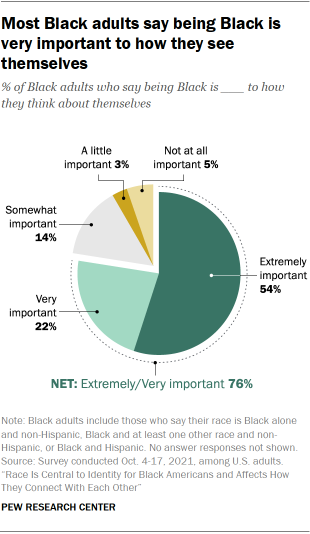
A significant share of Black Americans also say that when something happens to Black people in their local communities, across the nation or around the globe, it affects what happens in their own lives, highlighting a sense of connectedness. Black Americans say this even as they have diverse experiences and come from an array of backgrounds.
Even so, Black adults who say being Black is important to their sense of self are more likely than other Black adults to feel connected to other groups of Black people. They are also more likely to feel that what happens to Black people inside and outside the United States affects what happens in their own lives. These findings emerge from an extensive new survey of Black U.S. adults conducted by Pew Research Center.
A majority of non-Hispanic Black Americans (78%) say being Black is very or extremely important to how they think about themselves. This racial group is the largest among Black adults , accounting for 87% of the adult population, according to 2019 Census Bureau estimates. But among other Black Americans, roughly six-in-ten multiracial (57%) and Hispanic (58%) Black adults say this.
Black Americans also differ in key ways in their views about the importance of being Black to personal identity. While majorities of all age groups of Black people say being Black shapes how they think about themselves, younger Black Americans are less likely to say this – Black adults ages 50 and older are more likely than Black adults ages 18 to 29 to say that being Black is very or extremely important to how they think of themselves. Specifically, 76% of Black adults ages 30 to 49, 80% of those 50 to 64 and 83% of those 65 and older hold this view, while only 63% of those under 30 do.
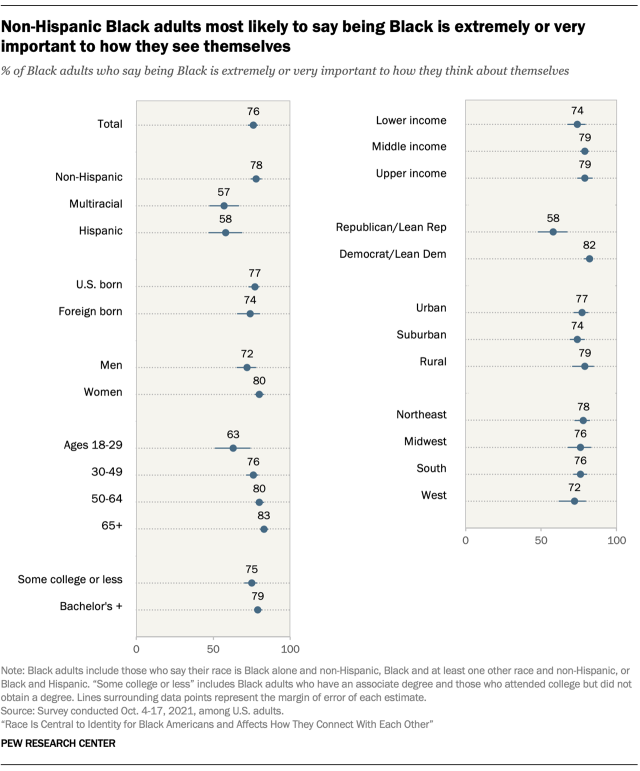
Black adults who identify with or lean toward the Democratic Party are more likely than those who identify with or lean toward the Republican Party to say being Black is important to how they see themselves – 86% vs. 58%. And Black women (80%) are more likely than Black men (72%) to say being Black is important to how they see themselves.
Still, some subgroups of Black Americans are about as likely as others to say that being Black is very or extremely important to how they think about themselves. For example, U.S.-born and immigrant Black adults are about as likely to say being Black is important to how they see their identity. However, not all Black Americans feel the same about the importance of being Black to their identity – 14% say it is only somewhat important to how they see themselves while 9% say it has little or no impact on their personal identity, reflecting the diversity of views about identity among Black Americans.
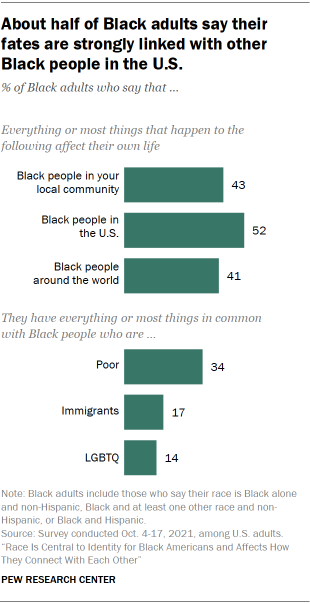
Beyond the personal importance of Blackness – that is, the importance of being Black to personal identity – many Black Americans feel connected to each other. About five-in-ten (52%) say everything or most things that happen to Black people in the United States affect what happens in their own lives, with another 30% saying some things that happen nationally to Black people have a personal impact. And 43% say all or most things that happen to Black people in their local community affect what happens in their own lives, while another 35% say only some things in their lives are affected by these events. About four-in-ten Black adults in the U.S. (41%) say they feel their fates are strongly linked to Black people around the world, with 36% indicating that some things that happen to Black people around the world affect what happens in their own lives.
The survey also asked respondents how much they have in common with different groups of Black Americans. Some 17% of Black adults say they have everything or most things in common with Black people who are immigrants. But this sense of commonality differs sharply by nativity: 14% of U.S.-born Black adults say they have everything or most things in common with Black immigrants, while 43% of Black immigrants say the same. Conversely, only about one-in-four Black immigrants (26%) say they have everything or most things in common with U.S.-born Black people, a share that rises to 56% among U.S.-born Black people themselves.
About one-third of Black Americans (34%) say they have everything or most things in common with Black people who are poor, though smaller shares say the same about Black people who are wealthy (12%). Relatively few Black Americans (14%) say they have everything or most things in common with Black people who identify as lesbian, gay, bisexual, transgender or queer (LGBTQ). However, a larger share of Black Americans (25%) say they have at least some things in common with Black people who identify as LGBTQ. All these findings highlight the diversity of the U.S. Black population and how much Black people feel connected to each other.
These are among the key findings from a recent Pew Research Center survey of 3,912 Black Americans conducted online Oct. 4-17, 2021. This report is the latest in a series of Pew Research Center studies focused on describing the rich diversity of Black people in the United States.
The nation’s Black population stood at 47 million in 2020 , making up 14% of the U.S. population – up from 13% in 2000. While the vast majority of Black Americans say their racial background is Black alone (88% in 2020), growing numbers are also multiracial or Hispanic. Most were born in the U.S. and trace their roots back several generations in the country, but a growing share are immigrants (12%) or the U.S.-born children of immigrant parents (9%). Geographically, while 56% of Black Americans live in the nation’s South , the national Black population has also dispersed widely across the country.
It is this diversity – among U.S.-born Black people and Black immigrants; between Black people who live in different regions; and across different ethnicities, party affiliations, ages and income levels – that this report explores. The survey also provides a robust opportunity to examine the importance of race to Black Americans’ sense of self and their connections to other Black people.
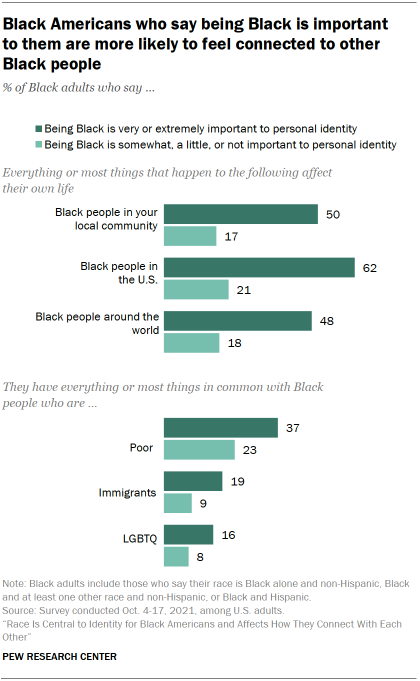
The importance of being Black to personal identity is a significant factor in how connected Black Americans feel toward each other. Those who say that being Black is a very or extremely important part of their personal identity are more likely than those for whom Blackness is relatively less important to express a sense of common fate with Black people in their local communities (50% vs. 17%), in the United States overall (62% vs. 21%), and even around the world (48% vs. 18%).
They are also more likely to say that they have everything or most things in common with Black people who are poor (37% vs. 23%) and Black immigrants (19% vs. 9%). Even so, fewer than half of Black Americans, no matter how important Blackness is to their personal identity, say they have everything or most things in common with Black people who are poor, immigrants or LGBTQ.
The new survey also explores Black Americans’ knowledge about their family histories and the history of Black people in the United States, with the importance of Blackness linked to greater knowledge.
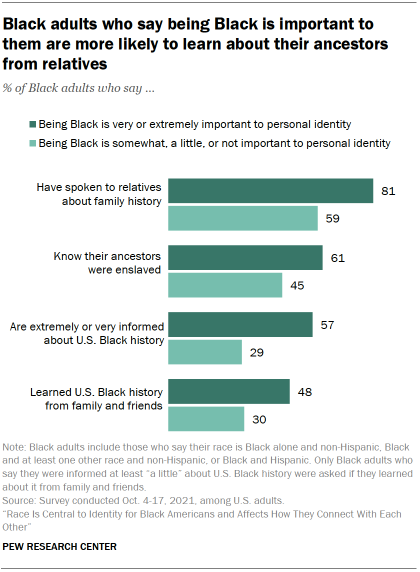
Nearly six-in-ten Black adults (57%) say their ancestors were enslaved either in the U.S. or another country, with nearly all who say so (52% of the Black adults surveyed) saying it was in the U.S., either in whole or in part. Black adults who say that being Black is a very or extremely important part of how they see themselves (61%) are more likely than those for whom being Black is less important (45%) to say that their ancestors were enslaved. In fact, Black adults for whom Blackness is very or extremely important (31%) are less likely than their counterparts (42%) to say that they are not sure if their ancestors were enslaved at all.
When it comes to learning more about their family histories, Black adults for whom Blackness is very or extremely important (81%) are more likely than those for whom Blackness is less important (59%) to have spoken to their relatives. They are about as likely to have researched their family’s history online (36% and 30%, respectively) and to have used a mail-in DNA service such as AncestryDNA or 23andMe (15% and 16%) to learn more about their ancestry.
The importance of Blackness also figures prominently into how informed Black Americans feel about U.S. Black history. Black adults who say Blackness is a significant part of their personal identity are more likely than those for whom Blackness is less important to say that they feel very or extremely informed about U.S. Black history (57% vs. 29%). Overall, about half of Black Americans say they feel very or extremely informed about the history of Black people in the United States.
Among Black adults who feel at least a little informed about U.S. Black history, the sources of their knowledge also differ by the importance of Blackness to personal identity. Nearly half of Black adults for whom Blackness is very or extremely important (48%) say they learned about Black history from their families and friends, making them more likely to say so than Black adults for whom Blackness is less important (30%). Similarly, those who say being Black is important to their identity are more likely than those who did not say this to have learned about Black history from nearly every source they were asked about, be it media (33% vs. 22%), the internet (30% vs. 18%) or college, if they attended (26% vs. 14%). The only source for which both groups were about equally likely to say they learned about Black history was their K-12 schools (24% and 21%, respectively).
Overall, among Black Americans who feel at least a little informed about U.S. Black history, 43% say they learned about it from their relatives and friends, 30% say they learned about it from the media, 27% from the internet, and 24% from college (if they attended) and 23% from K-12 school.
Black adults under 30 years old differ significantly from older Black adults in their views on the importance of Blackness to their personal identity. However, Black adults also differ by age in how they pursue knowledge of family history, how informed they feel about U.S. Black history, and their sense of connectedness to other Black people.
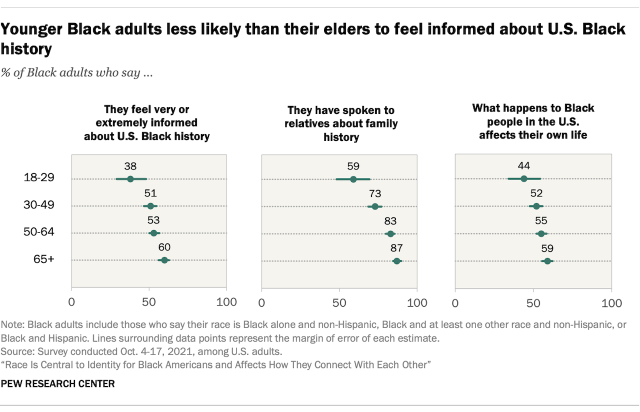
Black adults under 30 (50%) are less likely than those 65 and older (64%) to say their ancestors were enslaved. In fact, 40% of Black adults under 30 say that they are not sure whether their ancestors were enslaved. Black adults in the youngest age group (59%) are less likely than the oldest (87%) to have spoken to their relatives about family history or to have used a mail-in DNA service to learn about their ancestors (11% vs. 21%). They are only slightly less likely to have conducted research on their families online (26% vs. 39%).
Black adults under 30 have the lowest share who say they feel very or extremely informed about the history of Black people in the United States (40%), compared with 60% of Black adults 65 and older and about half each of Black adults 50 to 64 (53%) and 30 to 49 (51%). In fact, Black adults under 30 are more likely than those 50 and older to say they feel a little or not at all informed about Black history. While Black adults are generally most likely to cite family and friends as their source for learning about Black history, the share under 30 (38%) who also cite the internet as a source of information is higher than the shares ages 50 to 64 (22%) and 65 and older (14%) who say this.
These age differences persist in the sense of connectedness that Black Americans have with other Black people. Black adults under 30 are less likely than those 65 and older to say that everything or most things that happen to Black people in the United States will affect their own lives. This youngest group is also less likely than the oldest to have this sense of common fate with Black people in their local community. One exception to this pattern occurs when Black adults were asked how much they had in common with Black people who identify as LGBTQ. Black adults under 30 (21%) were considerably more likely than those 65 and older (10%) to say they have everything or most things in common with Black people who identify as LGBTQ.
Black Democrats and Republicans differ on how important Blackness is to their personal identities. However, there are also partisan gaps when it comes to their connectedness to other Black people. 1
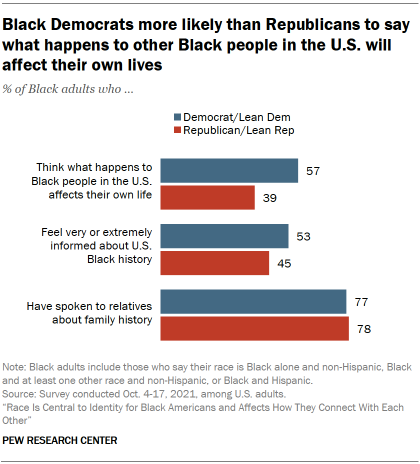
Black Democrats and those who lean to the Democratic Party are more likely than Black Republicans and Republican leaners to say that everything or most things that happen to Black people in the United States (57% vs. 39%) and their local communities (46% vs. 30%) affect what happens in their own lives. However, Black Republicans (24%) are more likely than Black Democrats (14%) to say that they have everything or most things in common with Black people who are LGBTQ. They are also more likely than Black Democrats to say they have everything or most things in common with Black people who are wealthy (25% vs. 11%).
When it comes to knowledge of family and racial histories, Black Democrats and Republicans do not differ. Democrats (59%) are just as likely as Republicans (54%) to know that their ancestors were enslaved. Nearly 80% of Black adults from both partisan coalitions say they have spoken to their relatives about their family history. Similar shares have also researched their family histories online and used mail-in DNA services.
Black Democrats are also not significantly more likely than Black Republicans to say they feel very or extremely informed about U.S. Black history (53% vs. 45%). And among those who feel at least a little informed about U.S. Black history, Democrats and Republicans are about equally likely to say they learned it from family and friends (45% vs. 38%).
Place is a key part of Black Americans’ personal identities
The majority of Black adults who live in the United States were born there, but an increasing portion of the population is comprised of immigrants. Of those immigrants, nearly 90% were born in the Caribbean or Africa . Regardless of their region of birth, 58% of Black adults say the country they were born in is very or extremely important to how they think about themselves. A smaller share say the same about the places where they grew up (46%).
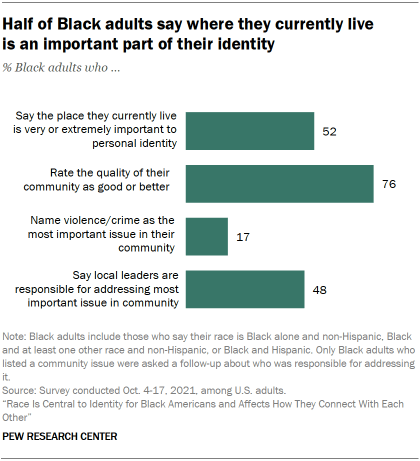
Black adults also feel strongly about their current communities. About half of Black adults (52%) say that where they currently live is very or extremely important to how they think about themselves. And when it comes to the quality of their neighborhoods, 76% of Black adults rate them as at least good places to live, including 41% who say the quality of their community is very good or excellent.
Still, Black adults say there are concerning issues in the communities they live in. When asked in an open-ended question to list the issue that was most important in their neighborhoods, nearly one-in-five Black adults listed issues related to violence or crime (17%). Smaller shares listed other points of concern such as economic issues like poverty and homelessness (11%), housing (7%), COVID-19 and public health (6%), or infrastructure issues such as the availability of public transportation and the conditions of roads (5%).
While nearly one-in-five Black Americans (17%) say that individual people like themselves should be responsible for solving these problems, they are most likely to say that local community leaders should address these issues (48%). Smaller shares say the U.S. Congress (12%), the U.S. president (8%) or civil rights organizations (2%) bear responsibility.
- According to the survey, 80% of Black adults say they identify with or lean toward the Democratic Party, 10% say the same of the Republican Party and 10% did not answer the question or indicated that they did not affiliate with either party. Among Black registered voters, the survey finds 85% identify with or lean toward the Democratic Party, 10% identify with or lean toward the Republican Party and 5% did not answer the question or indicated that they did not affiliate with either party. ↩
Sign up for our weekly newsletter
Fresh data delivery Saturday mornings
Sign up for The Briefing
Weekly updates on the world of news & information
- Black Americans
- Family & Relationships
- Gender & LGBTQ
- Racial & Ethnic Identity
- Rural, Urban and Suburban Communities
A look at Black-owned businesses in the U.S.
8 facts about black americans and the news, black americans’ views on success in the u.s., among black adults, those with higher incomes are most likely to say they are happy, fewer than half of black americans say the news often covers the issues that are important to them, most popular, report materials.
- American Trends Panel Wave 97
1615 L St. NW, Suite 800 Washington, DC 20036 USA (+1) 202-419-4300 | Main (+1) 202-857-8562 | Fax (+1) 202-419-4372 | Media Inquiries
Research Topics
- Age & Generations
- Coronavirus (COVID-19)
- Economy & Work
- Immigration & Migration
- International Affairs
- Internet & Technology
- Methodological Research
- News Habits & Media
- Non-U.S. Governments
- Other Topics
- Politics & Policy
- Race & Ethnicity
- Email Newsletters
ABOUT PEW RESEARCH CENTER Pew Research Center is a nonpartisan fact tank that informs the public about the issues, attitudes and trends shaping the world. It conducts public opinion polling, demographic research, media content analysis and other empirical social science research. Pew Research Center does not take policy positions. It is a subsidiary of The Pew Charitable Trusts .
Copyright 2024 Pew Research Center
Terms & Conditions
Privacy Policy
Cookie Settings
Reprints, Permissions & Use Policy

IMAGES
VIDEO
COMMENTS
Сultural Identity Essay Examples. First and foremost, a cultural identity essay is the one where you share your vision of the world and personality. Below is an example that you might consider when writing your next cultural identity essay. I was born in Italy to a German family. My mother comes from the capital of Germany - Berlin, while my ...
The Significance of Cultural Identity. 1 page / 482 words. Cultural identity is a complex and multifaceted aspect of individuals' lives, shaping their beliefs, values, and behaviors. It is crucial to understand the factors that contribute to cultural identity, as it plays a significant role in shaping individuals and societies.
Definition of a Cultural Identity Essay. Students undertake different writing exercises in the learning environment to develop their critical thinking, reflective, and analytical skills. Basically, one of these exercises is academic writing, and among different types of essays that students write is a cultural identity essay. In this case, it ...
Introduction. Cultural identity is a multidimensional concept that has fascinated scholars, researchers, and practitioners in (intercultural) communication and related disciplines over time. The year 2020 has witnessed renewed interests in and debates about a multiplicity of cultural identities, which demonstrate the concept's relevance in ...
Definition of a Cultural Identity Essay. A cultural identity paper is one that brings out the identity of a person concerning the place where they grew up, religion, economic, or family status. Cultural identity, therefore, means a group of people that one can identify within his/her essay. But wait, there's more!
Diversity essays ask students to highlight an important aspect of their identity, background, culture, experience, viewpoints, beliefs, skills, passions, goals, etc. Diversity essays can come in many forms. Some scholarships are offered specifically for students who come from an underrepresented background or identity in higher education. At ...
Cultural identity refers to the factors like race, religious background, customs, traditions, etc., followed by a person. It is not only based on belonging to a certain background, but the cultural identity also influences the similarities that students might have with other group members, including habits, customs, beliefs, faith, etc.
Cultural identity essay is based on a similar principle. It entails writing about a crucial cultural influence that has made you who you are today, forming your beliefs, ideas, as well as philosophies. A goal of such essay lies in proving to audience what makes you unique and describing your chosen cultural focus. For instance, write about ...
As a model, use the following ten-step plan as you write using race, ethnic, and cultural identity theory: Carefully read the work you will analyze. Formulate a general question after your initial reading that identifies a problem—a tension—related to a historical or cultural issue. Reread the work, paying particular attention to the ...
The widely accepted definition of cultural identity is that it is the concept or belief of belonging to a specific group of people. This is, of course, filled with many sub-factors and is debatable because of the various cultural, historical, and generational characteristics (among others) that one can use to classify oneself or a group ...
A cultural identity essay is a paper that you write exploring and explaining how your place of upbringing, ethnicity, religion, socio-economic status, and family dynamics among other factors created your identity as a person. Even facts such as what activities you took part in as a child can be part of your cultural identity.
Cultural identity can be expressed through certain styles of clothing or other aesthetic markers. Cultural identity is a part of a person's identity, or their self-conception and self-perception, and is related to nationality, ethnicity, religion, social class, generation, locality, gender, or any kind of social group that has its own distinct culture.
Essay On Cultural Identity. Culture identity development is an important part of every life due the emergence of self through primary and sociocultural contexts (Ecklund, 2016). These stages of development are made up of either a dominant or a non-dominant group and intersectional adaptation. More specifically, cultural identity is a self ...
Cooking rice is more accessible than cultivating it - you can quickly cook rice by boiling it in water. This reflects people rich in culture and tradition but who lives simpler life. 8. Identity And Culture: My Identity, Culture, And Identity by April Casas. "Every single one has their own unique identity and culture.
Essay Example: The journey into one's cultural realm is a labyrinthine expedition, traversing the intricacies of personal and collective identity. It entails an immersion into the labyrinth of traditions, ethos, and societal mores that thread through generations, etching indelible imprints upon
Cultural Identity and Heritage in the "Everyday Use" by Alice Walker. In the broad context, Walker designs the story to underscore the conflict that African Americans faced concerning their cultural identity and heritage after the abolition of slavery. Cultural Identity: Problems, Coping, and Outcomes.
We form a cultural identity when we subconsciously interpret and incorporate signals from the world around us into our own identity so we can belong. Therefore: Your cultural identity is a critical piece of your personal identity (and worldview) that develops as you absorb, interpret, and adopt (or reject) the beliefs, values, behaviors, and ...
Cultural diversity is a debatable, open-ended term, which generally refers to a reality of coexistence of diverse knowledge, beliefs, arts, morals, laws, customs, religions, languages, abilities and disabilities, genders, ethnicities, races, nationalities, sexual orientations, etc., of human beings. It could extend to the way people react to ...
Culture identity has a lot to do with mental health and how you are raised up. So, having the ability to be able to identify with culture benefits and makes the knowledge of humans stronger and able to relate to more people and interact and form groups with those in the same culture as them. It's helped by boosting their self-esteems when ...
Introduction. Becoming acquainted with one's identity is the life's work of the individual. One's identity is a delicate soup of childhood experiences, family life, geographical background, pop cultural influences, aspirations, talents, flaws, habits, and cultural influence. That last detail of one's identity is perhaps the trickiest to ...
Culture prescribes commonly accepted roles and. behavioral norms, communication patterns, and affectivity. Identity is the sensation and. perception of a self. Taken together, cultural identity ...
Cultural Identity can be most basically described as a sense of belonging within a group. It is formed due to companionship based on the same traditions, beliefs, social structures and languages. Cultural identity is specific for every person and isn't universally the same. In conjunction with this when an individual migrates or is removed from a community a person's mental and physical ...
I am a strong Mexican American female from the south of San Antonio and I am proud that this is my cultural identity. A person's identity is shaped by many elements such as nationality, physical appearance, race, ethnic group, religion, and language. All of these elements may affect one's identity but only few of them affect them significantly.
Cultural identity is an important contributor to people's wellbeing. Identifying with a particular culture helps people feel they belong and gives them a sense of security. An established cultural identity has also been linked with positive outcomes in areas such as health and education. It provides access to social networks, which provide ...
The terms "Black Americans", "Black people" and "Black adults" are used interchangeably throughout this report to refer to U.S. adults who self-identify as Black, either alone or in combination with other races or Hispanic identity.. Throughout this report, "Black, non-Hispanic" respondents are those who identify as single-race Black and say they have no Hispanic background.